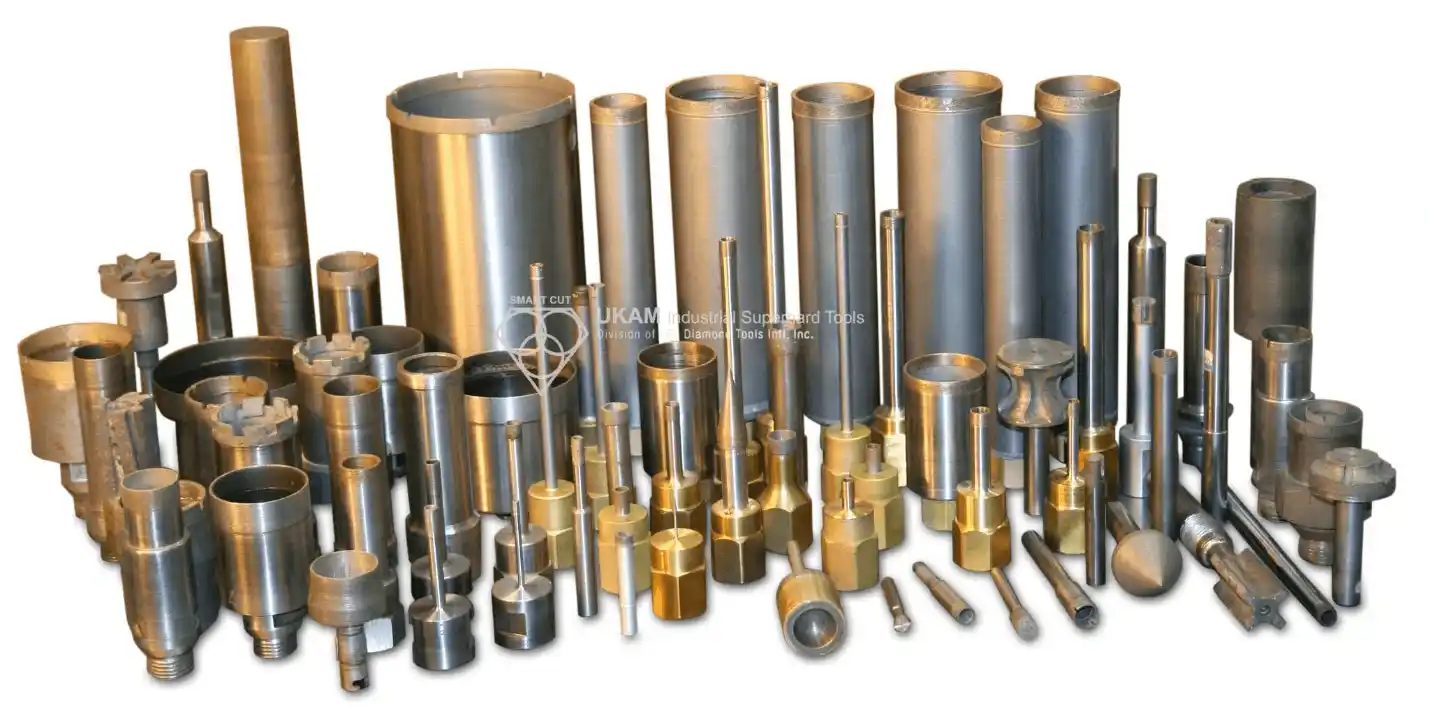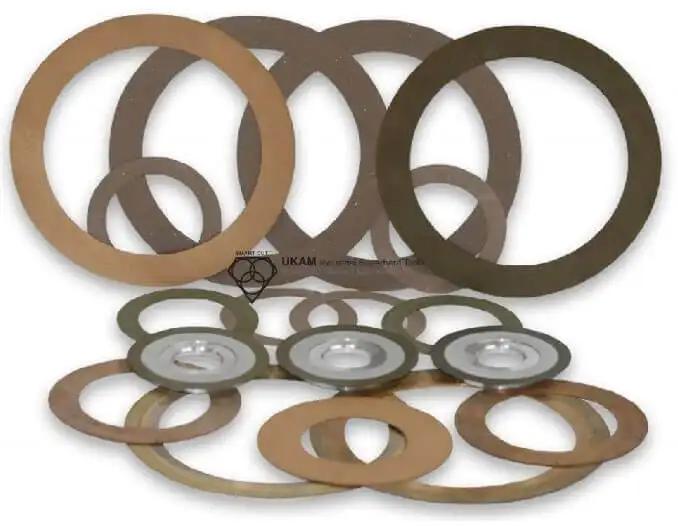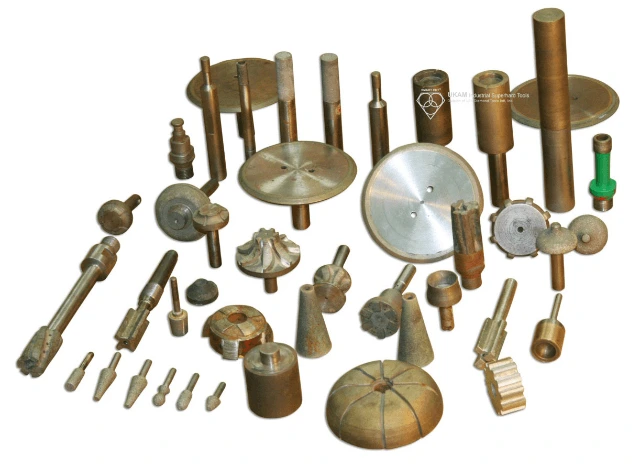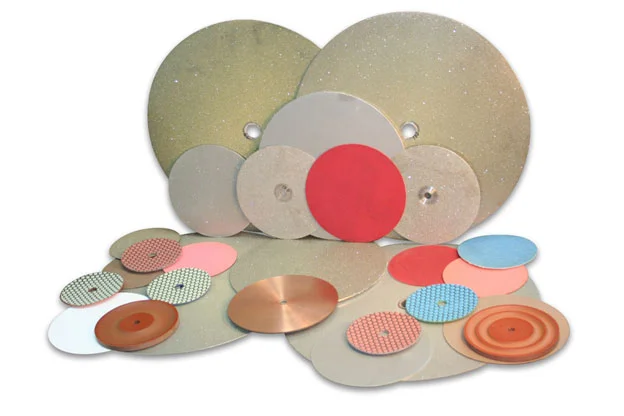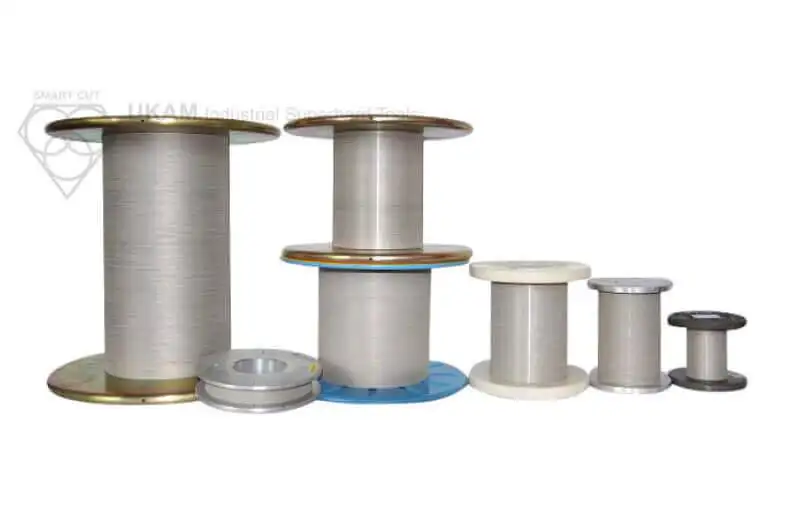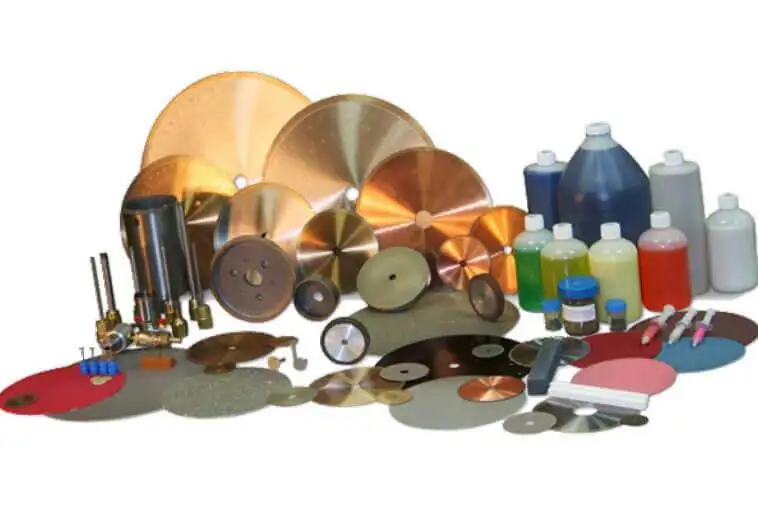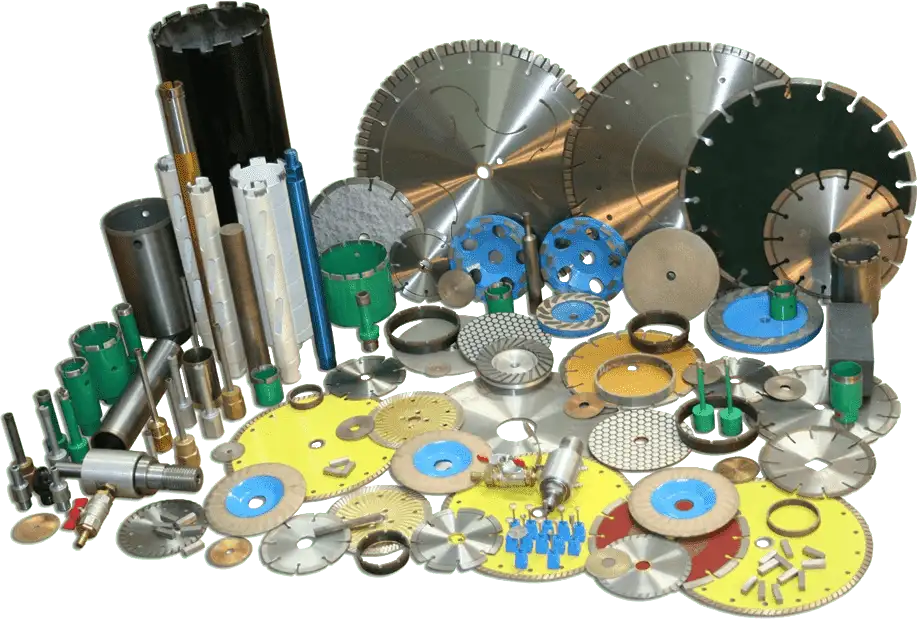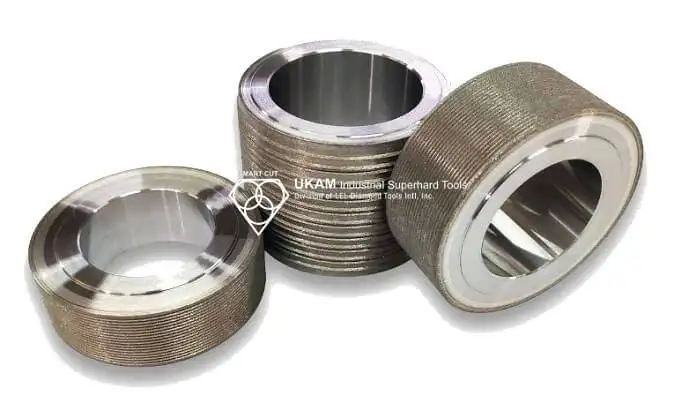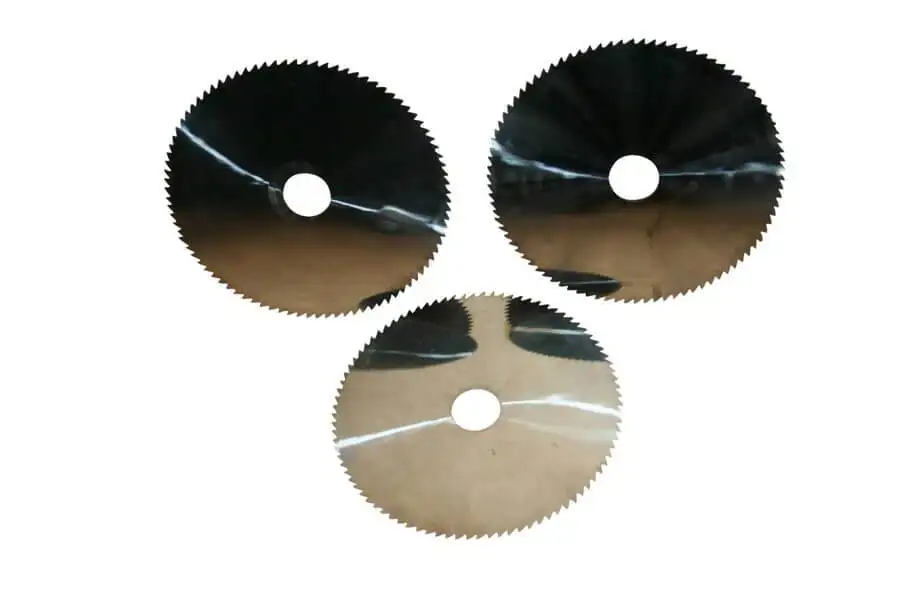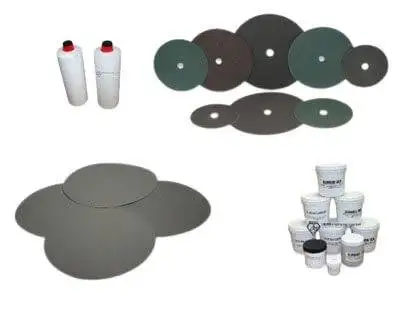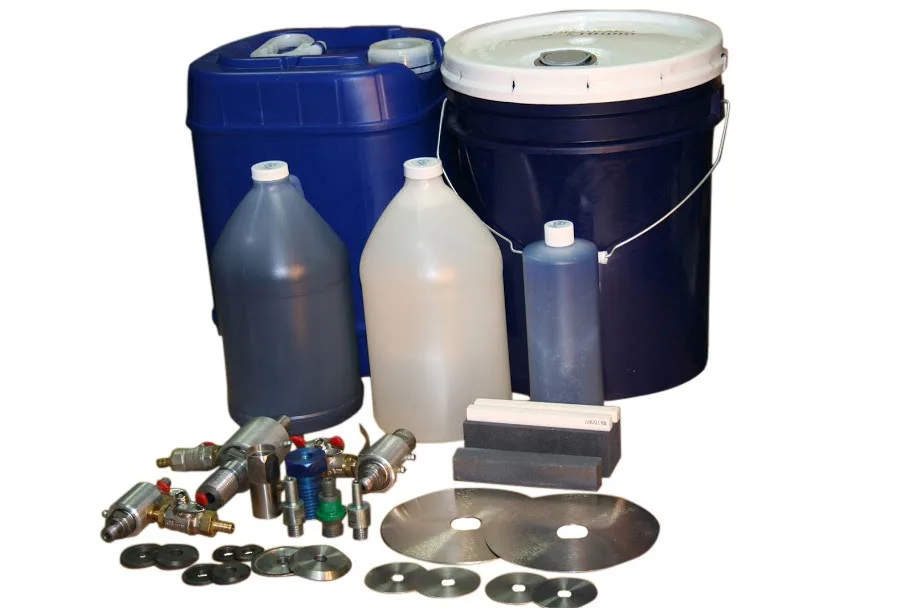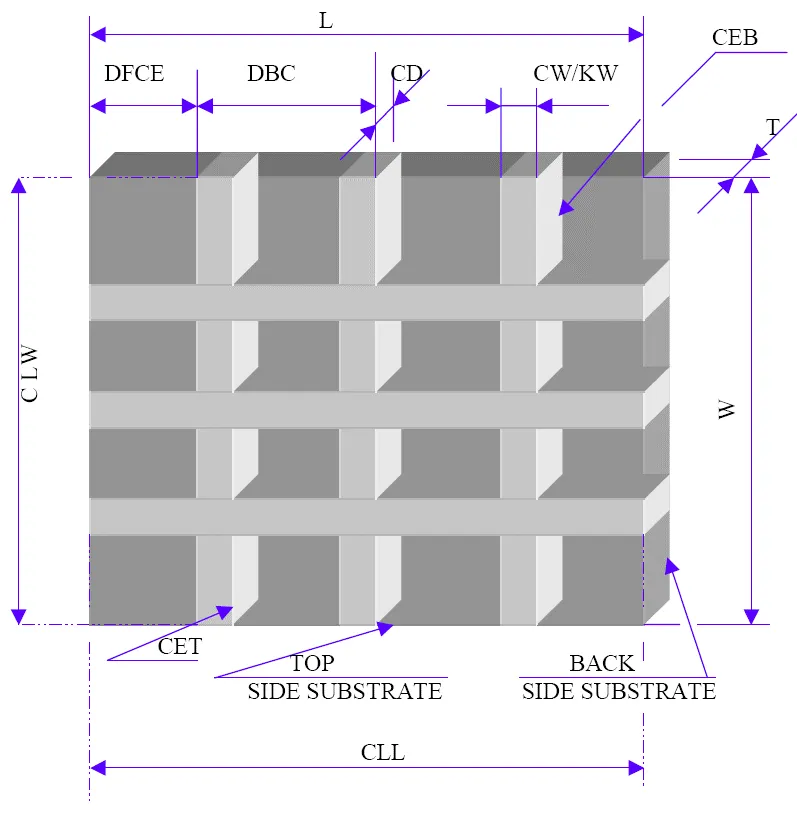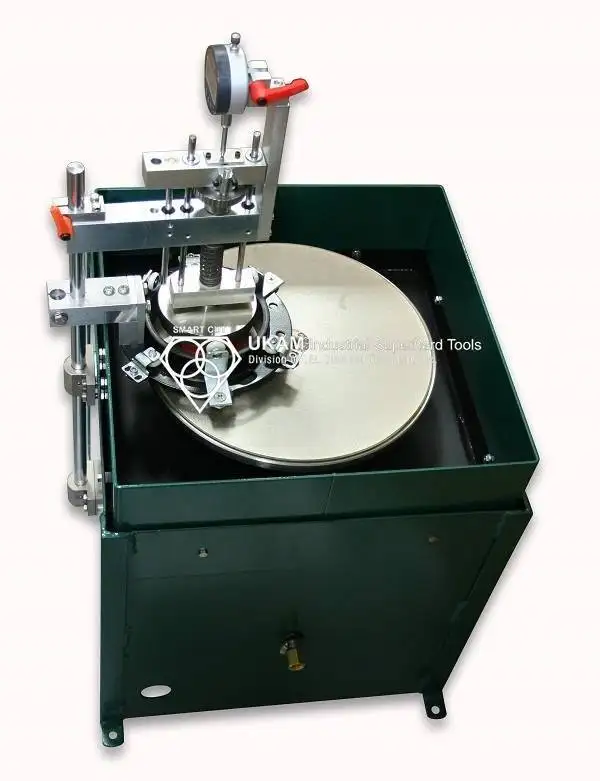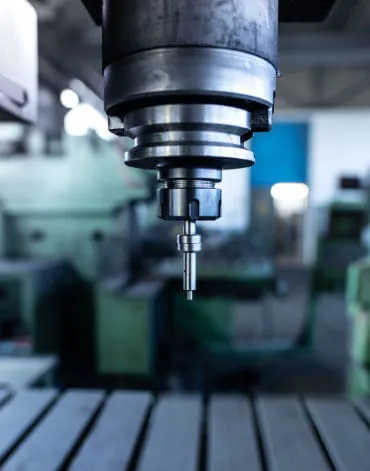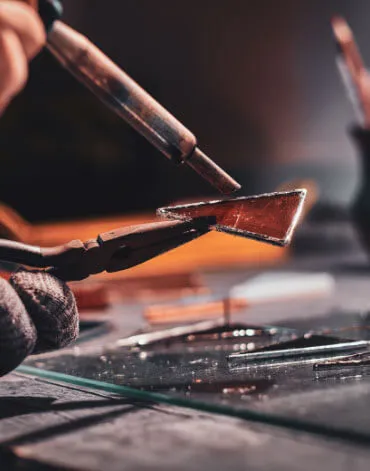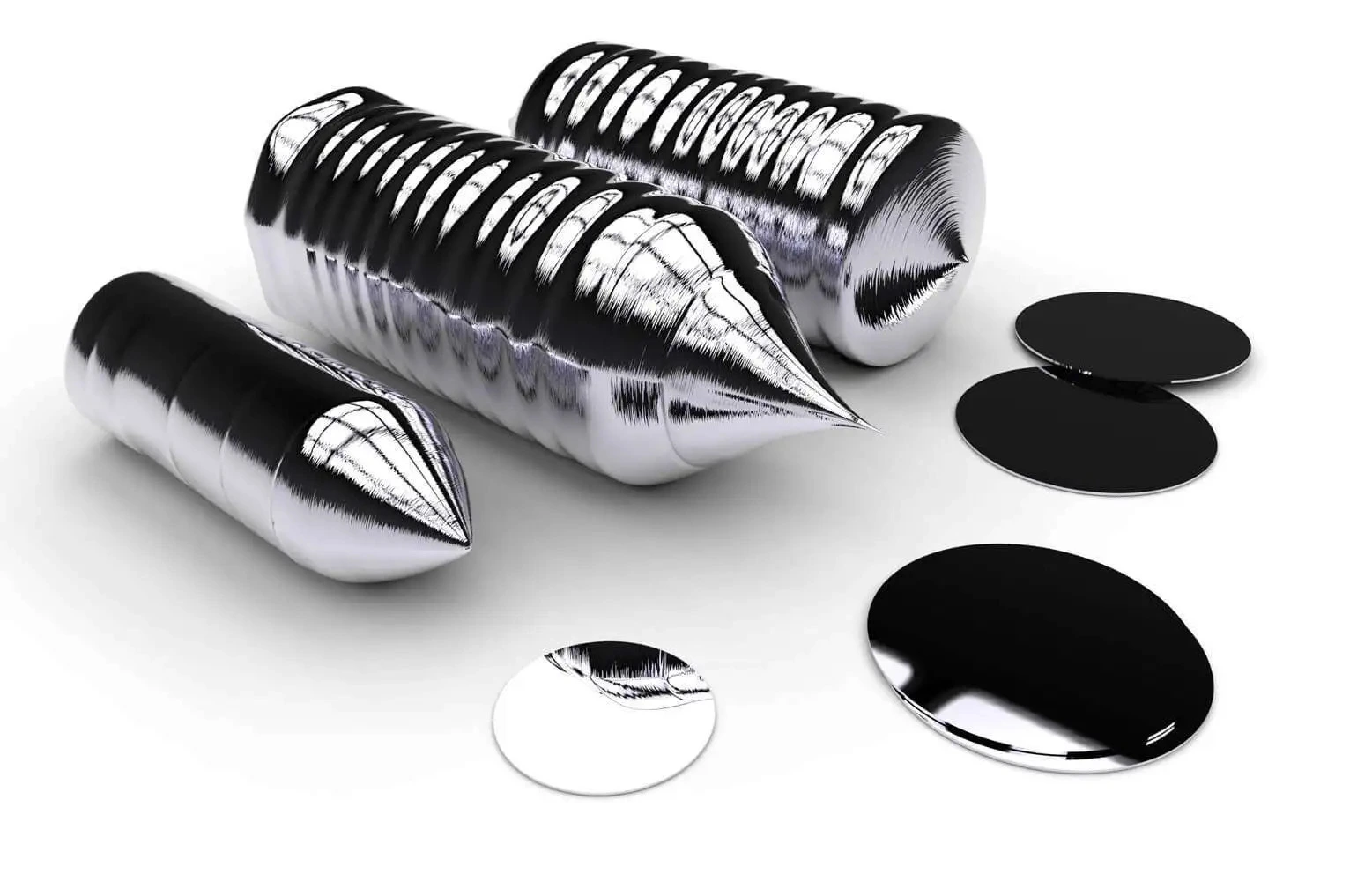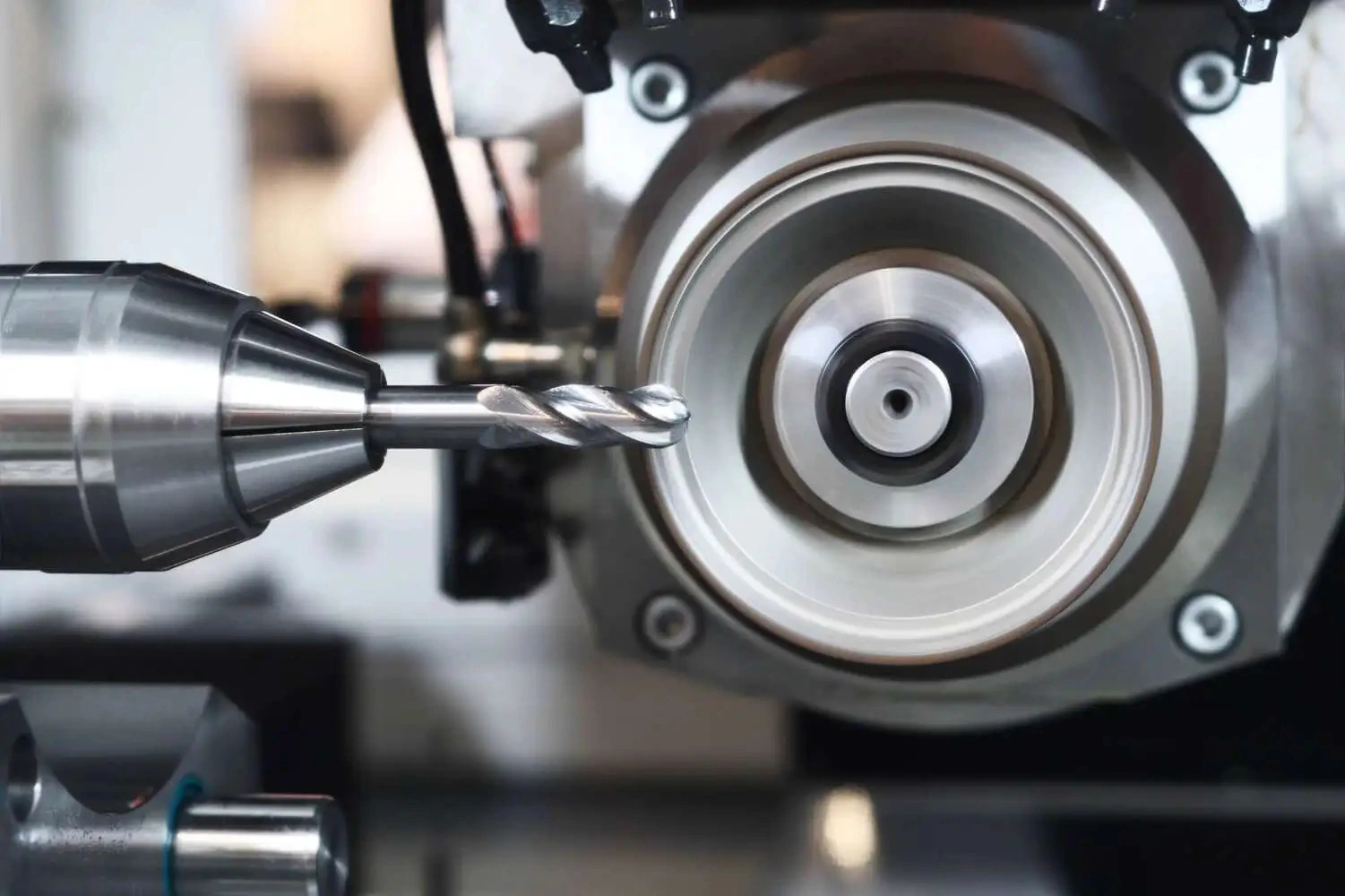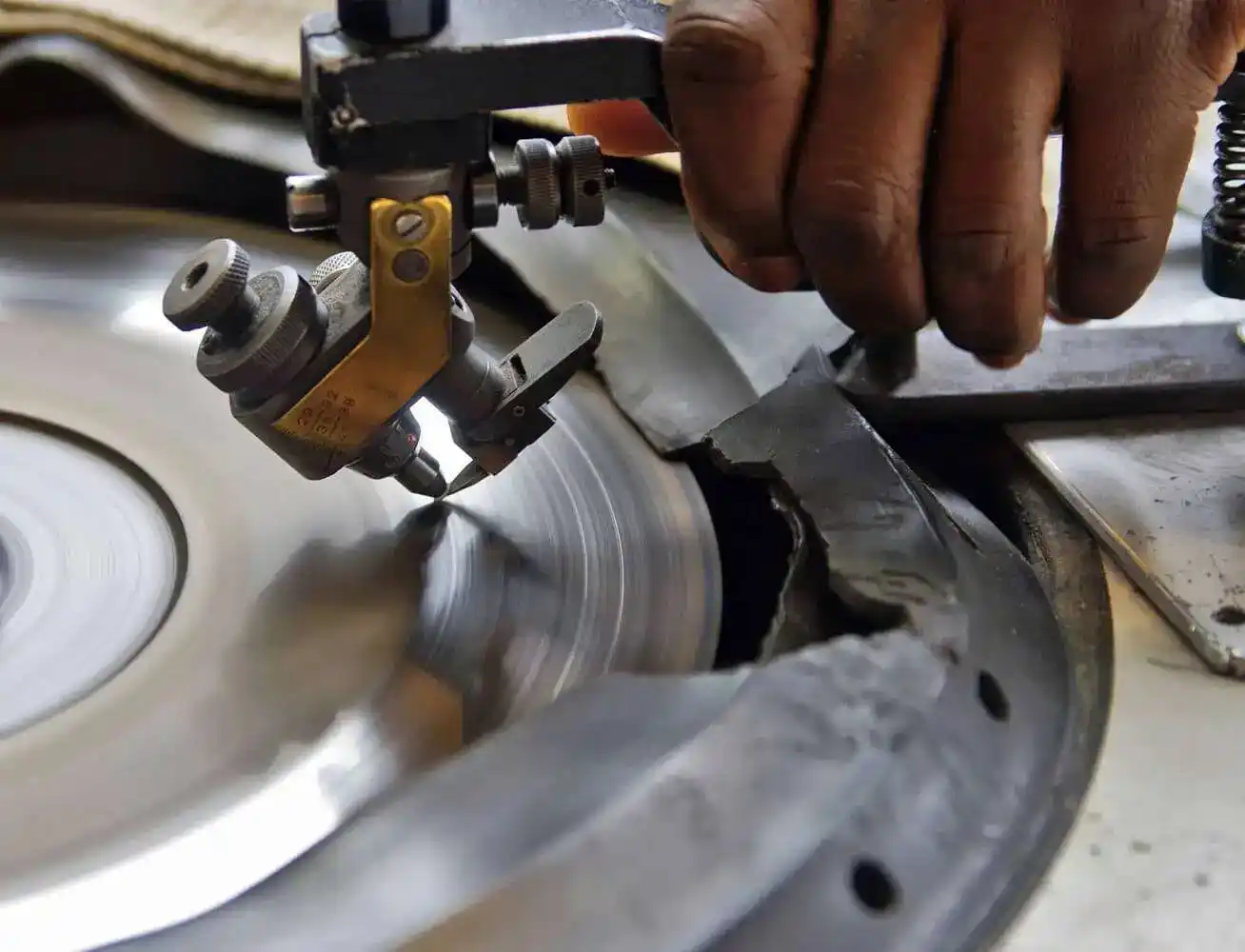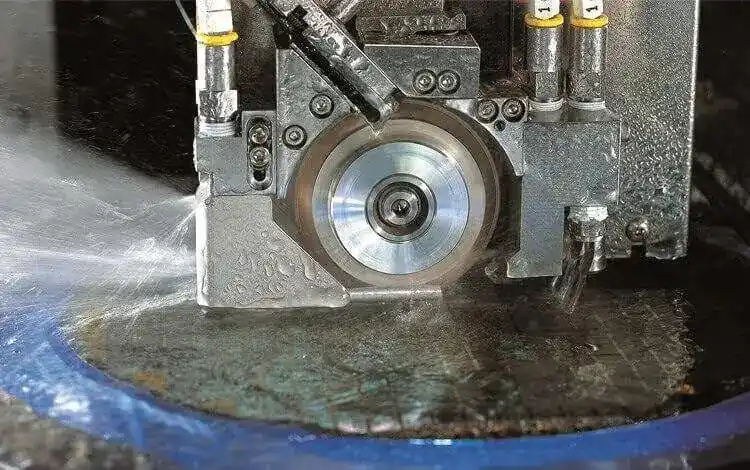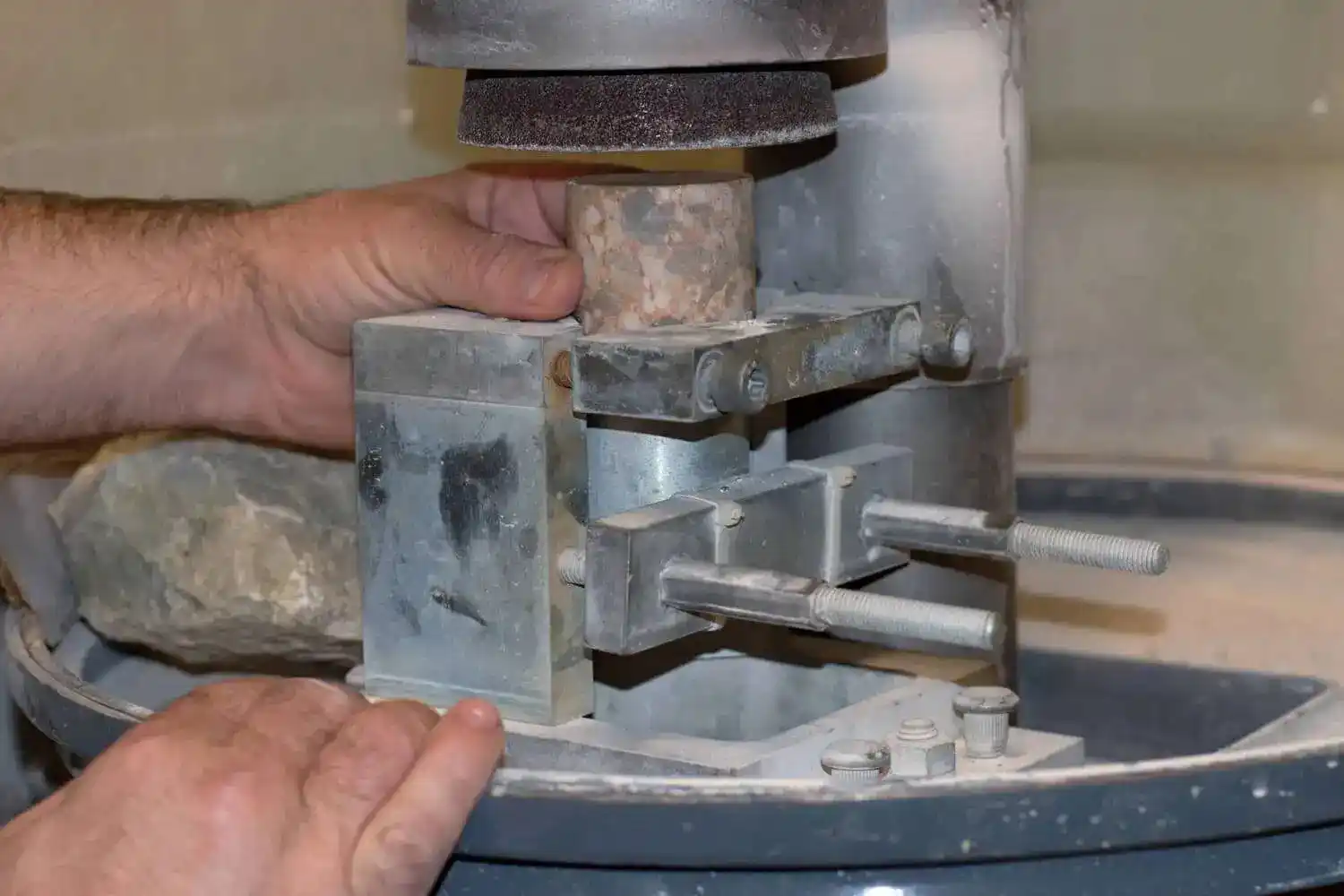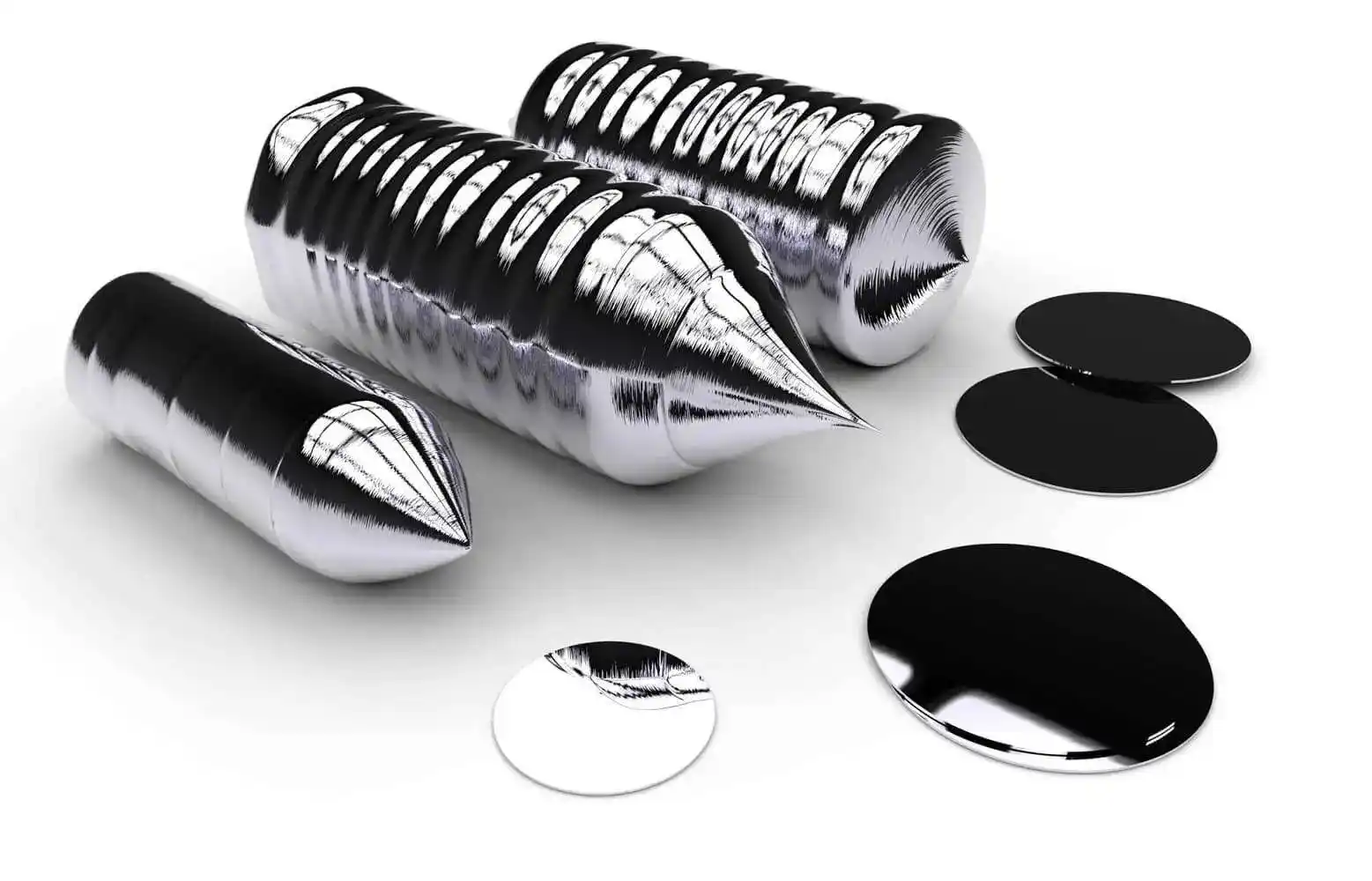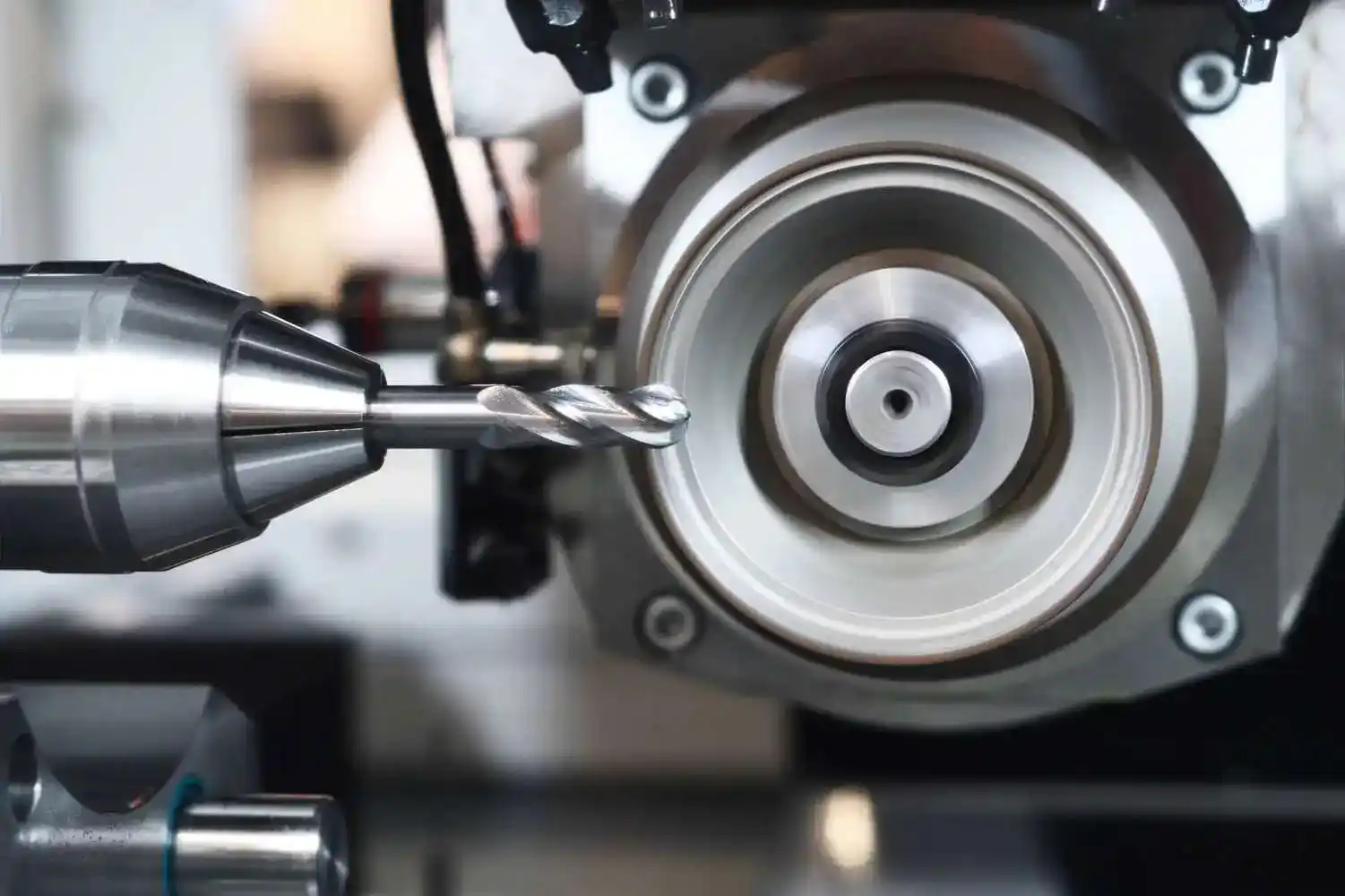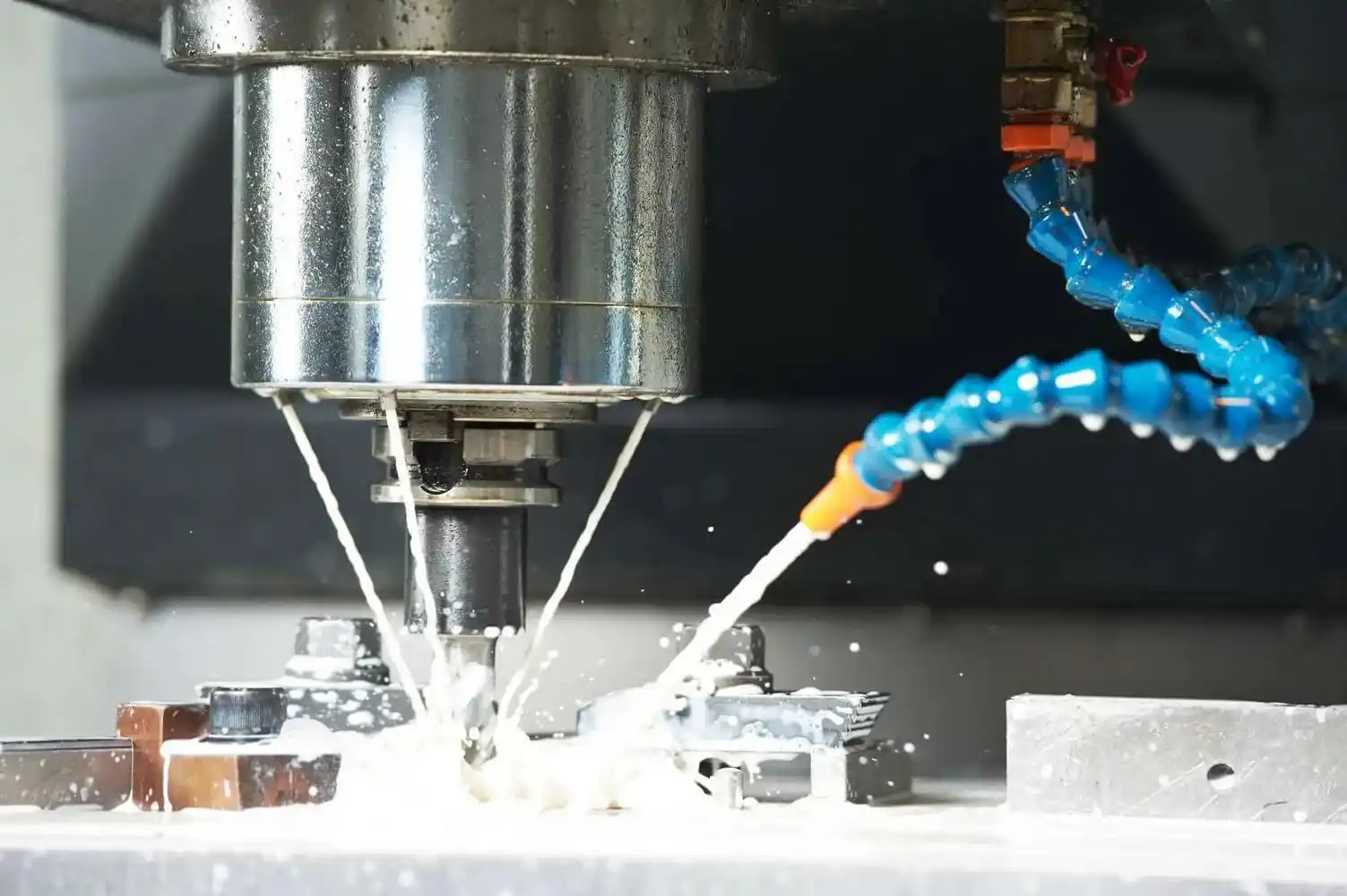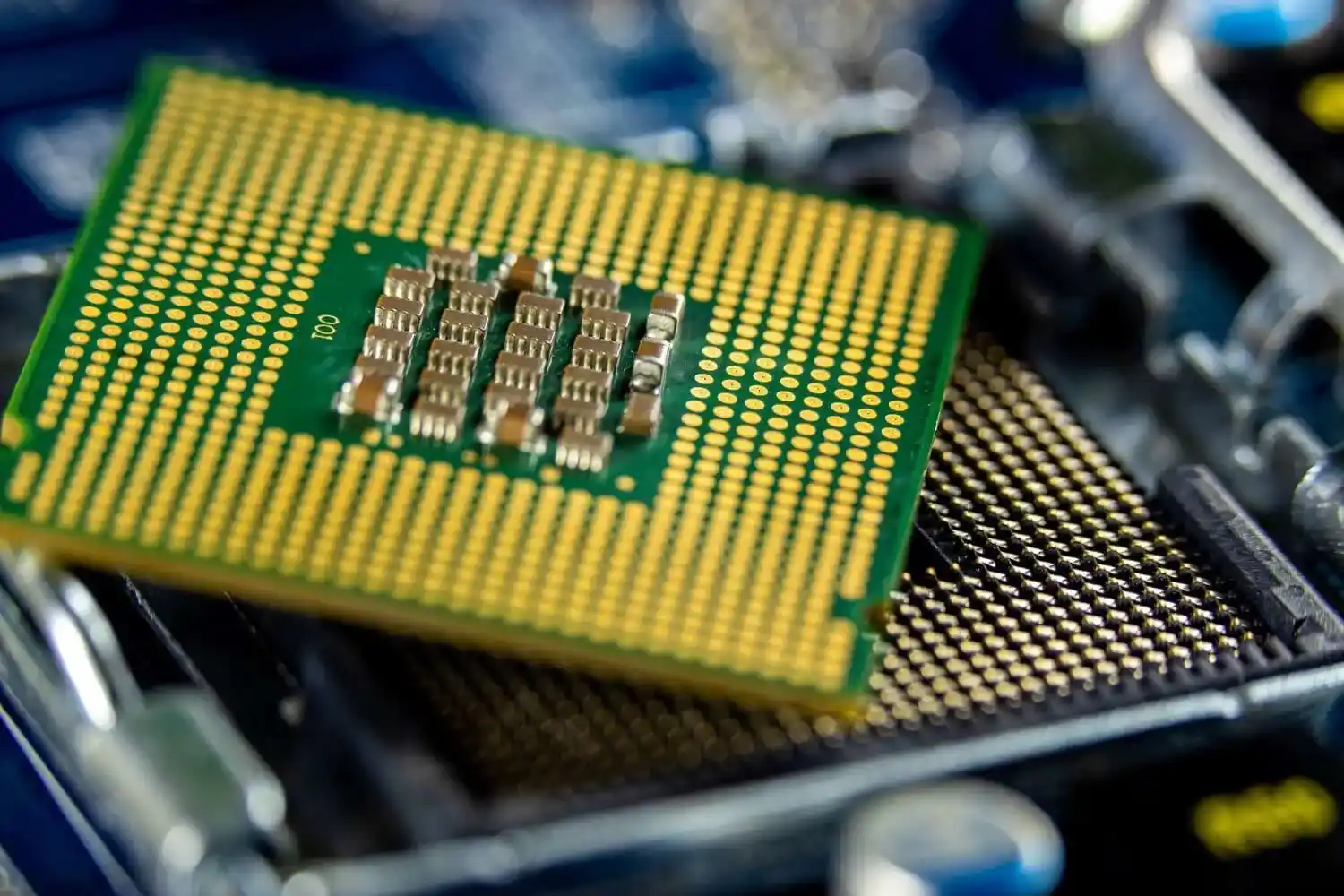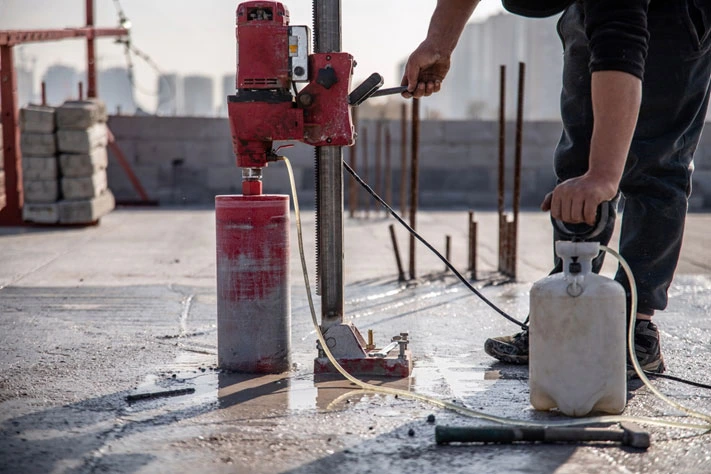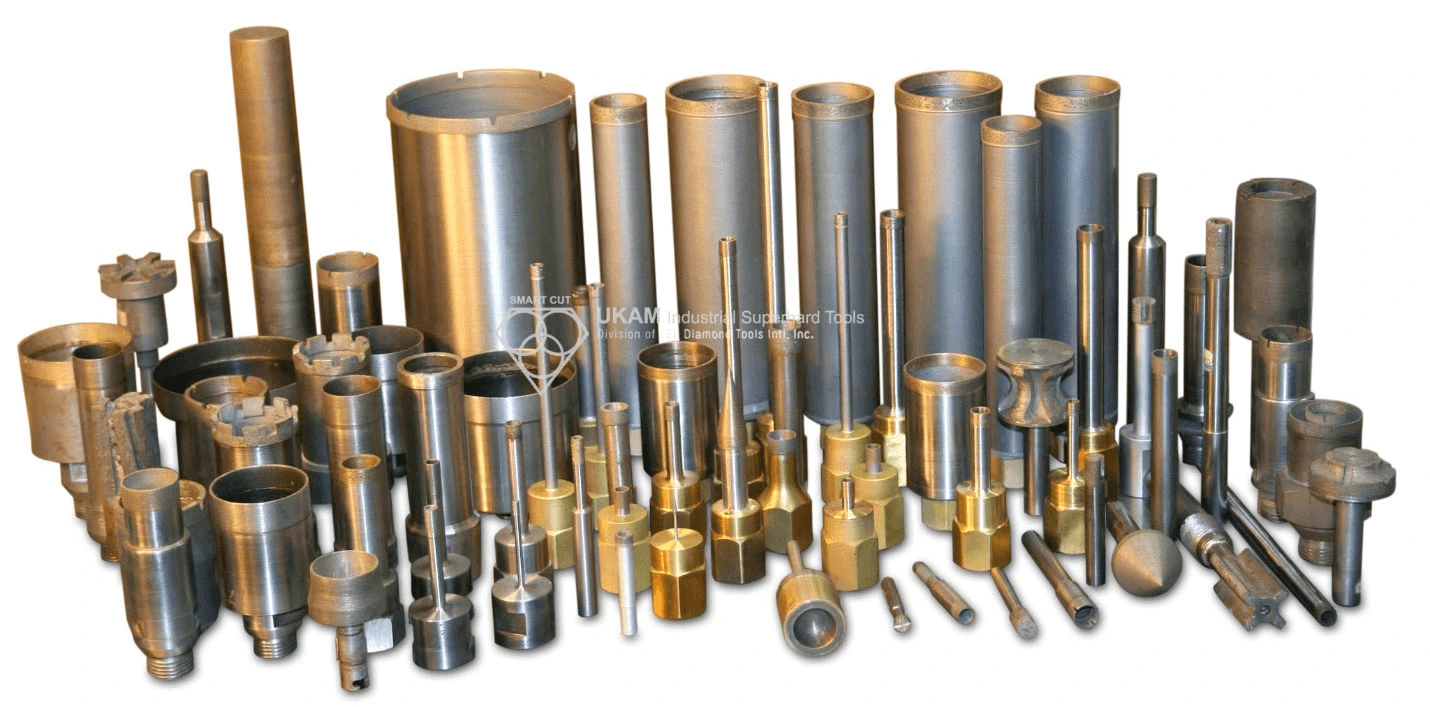Concrete Drilling Metrics – Optimizing your Diamond Core Bit
-
Posted by
 Brian Farberov
Brian Farberov

Table of Contents
ToggleRecommendations on speeds, feed rates and equipment to use to obtain best return on investment for using diamond core bits for drilling concrete and related materials
Share this Article with Friend or Colleague
Concrete Drilling Metrics
Optimizing your Diamond Core Bit
During the last decade concrete and construction industry has experienced sharp increases in labor rates, equipment costs, and overhead expenses. These increased costs had made the cost of diamond core bits used in drilling applications, a relatively minor factor in the overall cost equation. Given the high labor and overhead costs involved in most drilling operations, the speed with which the job is done is becoming ever most important. Today, in order to remain completive, the drilling operator must be able to accurately estimate amount of time, money, and resources a job will require. Unfortunately, today many drill operators waste valuable time and money. By using outdated drilling techniques and drilling equipment, that heavily relies on guessing and operator trial and error.
In an effort to help our customers provide more accurate system of estimating and predicting diamond drilling costs. As well as estimating time required to finish job and predicting diamond core bit performance on specific material type.
Several studies were conducted, revealing valuable solutions that you can start using today! Some of the variables evaluated in these studies include: applying different amounts of pressure to the diamond core bit, using higher horsepower hydraulic drilling equipment. As well as increasing the diamond core bit RPM’s (speed). By understanding these variables and how they work together, you will be able to increase the speed of which diamond core bit drills (penetrates) through material being drilled. Hence reducing amount of time spend on drilling.
New diamond core bit designs and segment matrix bond compositions have been designed to help increase drilling speed, without sacrificing diamond core bit life. Despite improvements in diamond core bit manufacturing technology, optimal balance of horse power and drilling force applied must still be achieved in order to obtain right combination of drilling sped and diamond bit life.
Optimum drilling horsepower is a function of both diameter of diamond bit and well as the type of concrete or allied material being drilled. To illustrate the interdependence of these two variables, several tests were conducted with three different diamond bit sizes to determine their optimum parameters. Using both reinforced and non reinforced concrete material. Special care was used to replicate true field drilling conditions in all aspects, from equipment used to typical procedures followed.
DRILLING REINFORCED AND NON-REINFORCE CONCRETE
Both types of concrete are commonly encountered in construction and highway drilling applications. Both materials require different drilling conditions and produce different drilling results. Drilling through a steel bar produces a different type of strain on the diamond bit and hence a different wear on the diamond bit cutting surface.
Drilling Non-Reinforced Concrete
Drilling process on plain concrete however is quiet different. Non-Reinforced Concrete material is removed by means of crack propagation. The diamond in the diamond bit produces stress on relatively brittle concrete which causes cracks to be generated. These cracks result in pieces of
concrete being broken away from the base material which allows the diamond bit to penetrate the material being drilled. This can usually be seen by the drilling swarf collected during the drilling of non reinforced concrete. Concrete chips are very rough and irregular in shape, indicated a brittle fracture.
Drilling Reinforced Concrete
Drilling action is reinforced concrete is quiet different. Most users find it more difficult, takes longer, and cost more to drill reinforced concrete than any other concrete or allied material. In Reinforced Concrete, the steel bar is cut by diamond crystals n a “machining” mode rather than by fracturing. You can usually see drilling swarf that contains particles of steel that are shaped like “curls”. Drilling reinforced concrete puts a very high strain of diamond core bit cutting surface. When drilling through the reinforced bar, the drilling surface of the diamond bit encounters a very tough and relatively ductile material. However as the diamond bit rotates the same section of cutting surface encounters the relatively brittle concrete. This causes loading and unloading of diamond bond material and diamond crystals.
Diamond core bit life and drilling speed is considerably reduced when drilling this material. On many applications diamond core bit life can be reduced by as much as 50% depending on steel amount and depth in concrete.
When a diamond core bit reaches and hits steel, you will often notice sparks coming from the drilling zone. This is an indicator that you have hit reinforced steel. The operator should reduce drilling speed and decrease coolant flow.
When the diamond bit is rotating at 500RPM each segment of diamond core bit penetrates rebar 1000 times per minute or 17 times per second. Resulting in more rapid breakdown of diamond bond matrix. What follows is increased diamond pullouts and possible premature fracture of diamond in bond matrix.
Determining Optimal Drilling Speed (Feed rate/ Penetration Rate) And Drilling Ratio
In order to determine most optimal feed rate (penetration) and drilling ration, several tests were structured using 3 different diameter diamond core bits. Horsepower of drilling machine was increased from 1.5 to 5 H.P. and 2” diameter diamond bit showed sharp increase in penetration rate and equally rapid decrease in drilling ratio. Thin wall diamond core bit was used in the first test.
Its relatively small surface area of 0.81 sq in resulted in a very high unit pressure (PSI) on drilling surface. Hence the concrete material was removed rapidly. The sight affects was fast wearing of the diamond core bit section. This was specially true at higher horsepower levels on reinforced concrete.

The steel bar accelerated the wear on the bit because the increase stress on the bond matrix and diamond crystals. The rebar also caused a reduction in the penetration rate (drilling speed) due to the difficulty in drill the steel.
For the 4” diameter diamond bit, increasing horsepower from 1.5 HP to 7 H produced significantly increase in penetration rate with only gradual decrease in drilling ratio. The decrease in drilling ratio was much slower than what occurred for 2” diameter bit because the larger surface area of the 4” diameter diamond bit distributed the thrust over a wider area. The penetration rate in non reinforced
concrete continued to increase even at highest horsepower used in test 7 HP. However in reinforced concrete drilling ratio dropped rapidly as horsepower was increased. Similarly penetration rate reached a plateau at about 4 HP. Using power above this level in reinforced concrete produced only minor increases in Penetration Rate.
For the 6” diameter diamond bit, the penetration rate continued to increase as horsepower was increased in both the reinforced and non reinforced concrete. The large cutting surface area of the 6” diamond concrete bit cause the bit thrust to be more widely distributed. Hence producing lower unit pressure on drilling surface. In non reinforced concrete, penetration rate continued to increase at highest power used 7 HP, with only gradual decrease in drilling ration. In reinforced concrete, 6” diamond concrete bit reached a penetration rate plateau at approximately 6 HP.
Optimal Concrete Drilling Cost Equation
Differences in horsepower and diamond core bit feed rates results in a different combination of diamond core bit life. (Drilling Ratio) and sped of drilling (Feed Rate or Penetration Rate). There is an ideal horsepower of each diamond core bit and material combination. The ideal horsepower would be at the point where the sum of the costs associated with diamond core bit life and operating costs are at the lowest point.
In order to determine the optimum horsepower for the three different size diamond core bits used in this experiment, an equation was derived to determine drilling cost rate as a function of Penetration Rate (PR) and Drilling Ration (DR).

DRILLING COST = Diamond Core Bit Cost + Operation Cost
Drilling Cost = (Diamond Core Bit Price + OCR)
Distance Drilled (DR x Segment Height PR)
Distance Drilled = Number of inches drilled
Diamond Core bit Price = Initial cost of diamond core bit
DR = Drilling Ration (inches drilled per thousands inch of diamond core bit wear)
Segmented Height = Total available segment height expressed in thousands of an inch
Operating cost Rate (OCR) = Cost of labor, overhead, and equipment expressed in dollars per minute
PR = Penetration Rate expressed in inches per minute
We will use the equation to determine the cost of drilling for the three different diamond core bit sizes tested in this experiment for both reinforced and non reinforced concrete
Distance Drilled = 100 inches
Diamond core Bit Price = 2” diameter ($200.00), 4” diameter ($325.00), 6” diameter ($550.00)
Segment Height = 0.3 inches
Given:
-
 Distance Drilled = 100 inches
Distance Drilled = 100 inches
-
 Segment Height = 0.3 inches (300 thousands of an inch)
Segment Height = 0.3 inches (300 thousands of an inch)
-
 Operating Cost Rate (OCR) = $25.00 per hour ($0.4167 per minute)
Operating Cost Rate (OCR) = $25.00 per hour ($0.4167 per minute)
-
 Penetration Rate (PR) = assumed to be a constant value (we will need to assume a value for PR, let’s use 1 inch per minute for simplicity)
Penetration Rate (PR) = assumed to be a constant value (we will need to assume a value for PR, let’s use 1 inch per minute for simplicity)
-
 Diamond Core Bit Prices: 2” diameter ($200.00), 4” diameter ($325.00), 6” diameter ($550.00)
Diamond Core Bit Prices: 2” diameter ($200.00), 4” diameter ($325.00), 6” diameter ($550.00)
-
 Drilling Ratio (DR): needs to be provided or assumed (we will assume 100 for this example)
Drilling Ratio (DR): needs to be provided or assumed (we will assume 100 for this example)
Calculations:
-
Calculate the Diamond Core Bit Cost:
Diamond Core Bit Cost = (Distance Drilled * Diamond Core Bit Price) / (DR * Segment Height)
-
Calculate the Operating Cost:
Operating Cost = (OCR * Distance Drilled) / PR
-
Calculate the Total Drilling Cost
Drilling Cost = (Diamond Core Bit Price + OCR) / (DR * Segment Height * PR)
Using the Assumptions:
- DR (Drilling Ratio) = 100
- PR (Penetration Rate) = 1 inch per minute
1. Calculate Diamond Core Bit Cost:
For each bit size:
- 2" diameter ($200.00)
- 4" diameter ($325.00)
- 6" diameter ($550.00)
2. Calculate Operating Cost:
Operating Cost = 0.4167 x 100 = 41.67
3. Calculate Total Drilling Cost:
For each bit size, we can use the formula.
Let's proceed to calculate and graph the costs.
Step 1: Calculate Costs for Each Bit Size
2" Diameter Bit:
-
Diamond Core Bit Cost:
Diamond Core Bit Cost = (100 x 200) / (100 x 300) = 20000 / 30000 = 0.6667
-
Total Drilling Cost:
Drilling Cost = (200 + 41.67) / (100 x 300 x 1) = 241.67 / 30000 = 0.0081
4" Diameter Bit:
-
Diamond Core Bit Cost:
Diamond Core Bit Cost = (100 x 325) / (100 x 300) = 32500 / 30000 = 1.0833
-
Total Drilling Cost:
Drilling Cost = (325 + 41.67) / (100 x 300 x 1) = 366.67 / 30000 = 0.0122
6" Diameter Bit:
-
Diamond Core Bit Cost:
Diamond Core Bit Cost = (100 x 550) / (100 x 300) = 55000 / 30000 = 1.8333
-
Total Drilling Cost:
Drilling Cost = (550 + 41.67) / (100 x 300 x 1) = 591.67 / 30000 = 0.0197
-
Breakdown of Costs by Bit Size
A bar chart showing the Diamond Core Bit Cost and Operating Cost separately for each bit size.
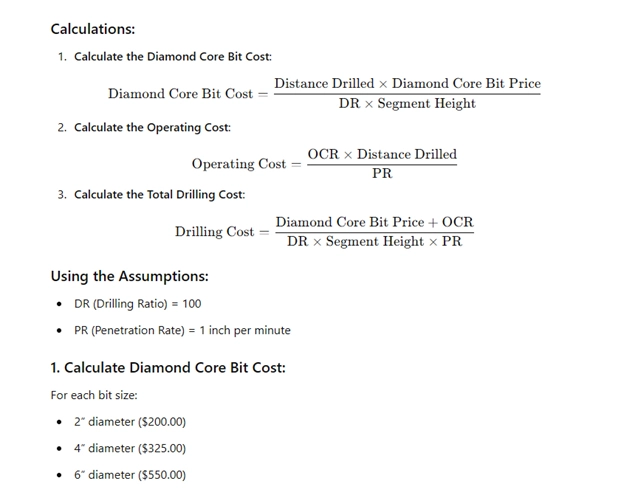
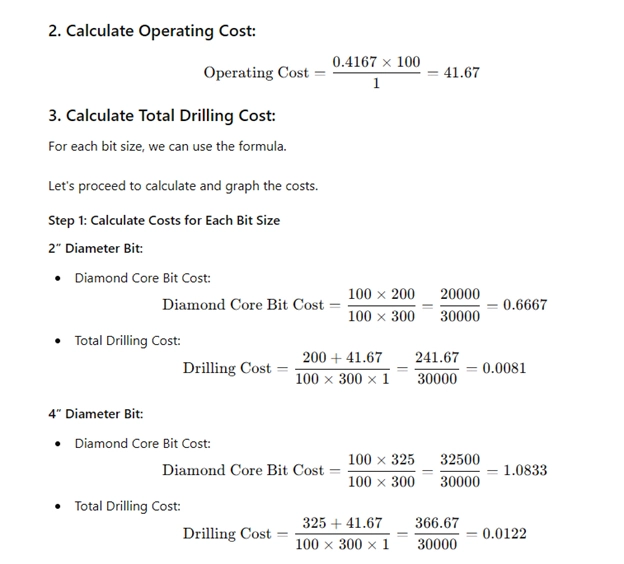

Cost per Inch Drilled
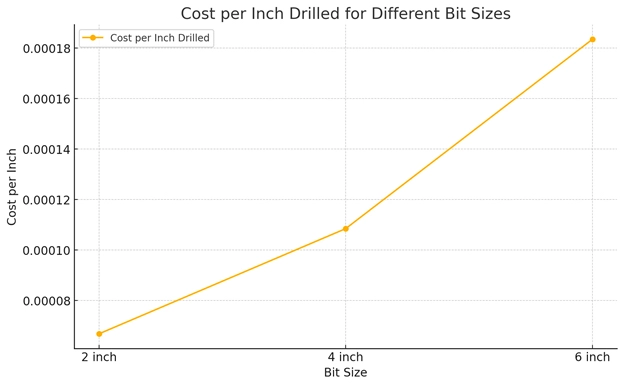
A line graph showing the cost per inch drilled for each bit size, highlighting the efficiency of each bit in terms of cost.
Effect of Drilling Ratio (DR) on Costs
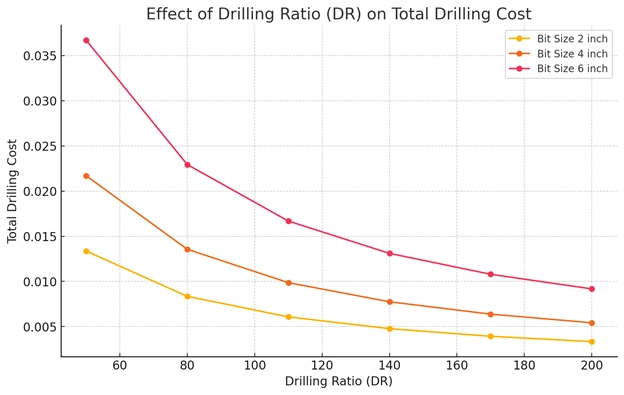
A line graph showing how changes in the Drilling Ratio (DR) affect the total drilling cost for each bit size.
Effect of Penetration Rate (PR) on Costs
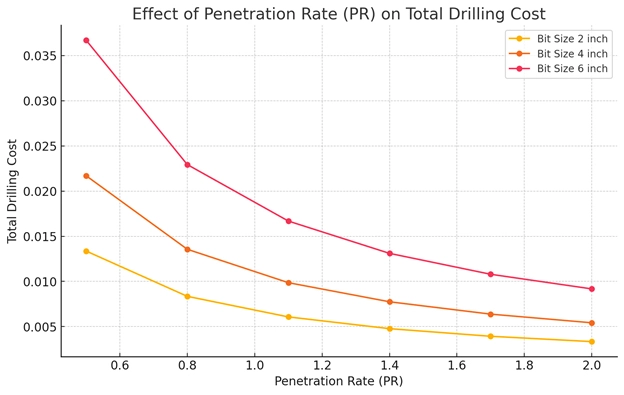
A line graph showing how variations in the Penetration Rate (PR) influence the total drilling cost for each bit size.
Cumulative Cost Over Distance Drilled

A cumulative cost graph showing how the total cost accumulates as the distance drilled increases for each bit size.
As you can see there is an optimum horsepower for each combination of diamond core bit diameter and material. Optimum horsepower can be determined where sum of the Diamond core Bit cost and Operating Cost are at a minimum. Conditions used in this experiment resulted in the following optimum drilling horsepower
Non Reinforced Concrete Reinforced Concrete
2” diameter 3.5 HP 1.5 HP
4” diameter 5.0 HP 3.0 HP
6” diameter 8.0 HP 3.5 HP
horsepower levels above were determined assuming standard Operating cost of $25.00 per hour.
Given Data and Assumptions:
- Distance Drilled (DD): 100 inches
- Segment Height (SH): 0.3 inches
- Operating Cost Rate (OCR): $25.00 per hour ($0.4167 per minute)
- Penetration Rate (PR): 1 inch per minute
- Diamond Core Bit Prices: 2" diameter ($200.00), 4" diameter ($325.00), 6" diameter ($550.00)
- Drilling Ratio (DR): 100 (assumed)
Calculations:
-
Calculate the number of bits needed:
- Each bit can drill up to Segment Height x Drilling Ratio inches before replacement
- Number of Bits Needed = Distance Drilled / (Segment Height x Drilling Ratio)
-
Calculate the total cost of diamond core bits:
- Total Bit Cost = Number of Bits Needed x Bit Price
-
Calculate the time to drill the given distance:
- Time to Drill = Distance Drilled / Penetration Rate minutes
-
Calculate the operating cost:
- Operating Cost = Time to Drill x Operating Cost Rate per Minute
-
Sum the bit cost and operating cost to get the total cost.
Let's perform these calculations for each diameter option under the provided conditions.
Core Bit Lifespan Calculation:
- Bit Lifespan: 0.3 x 100 = 30 inches
Number of Bits Needed:
- 100 / 30 ≈ 3.33 bits (round up to 4 bits for practical purposes)
Non-Reinforced Concrete
-
2" Diameter
- Bit Cost: 4 x 200.00 = 800.00
- Time to Drill: 100 / 1 = 100 minutes
- Operating Cost: 100 x 0.4167 = 41.67
- Total Cost: 800.00 + 41.67 = 841.67
-
4" Diameter
- Bit Cost: 4 x 325.00 = 1300.00
- Time to Drill: 100 minutes
- Operating Cost: 100 x 0.4167 = 41.67
- Total Cost: 1300.00 + 41.67 = 1341.67
-
6" Diameter
- Bit Cost: 4 x 550.00 = 2200.00
- Time to Drill: 100 minutes
- Operating Cost: 100 x 0.4167 = 41.67
- Total Cost: 2200.00 + 41.67 = 2241.67
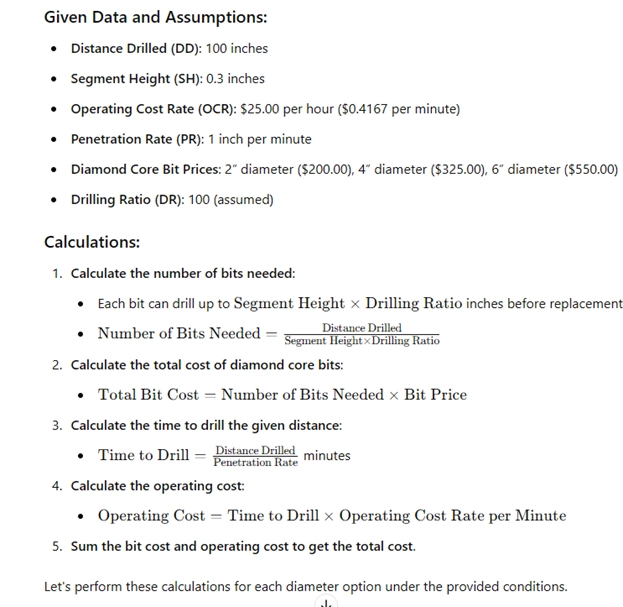
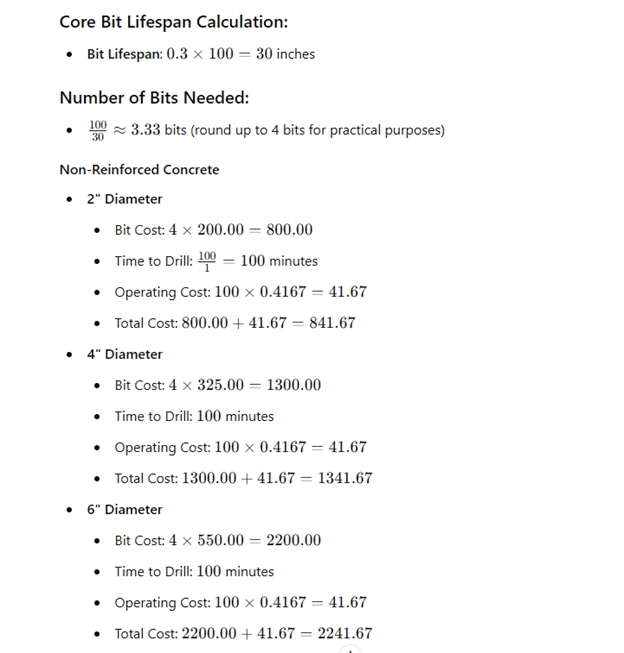
To effectively visualize the data from the calculations, we can create a couple of graphs:
-
 Total Cost by Diameter (Left Graph): This bar graph shows the total costs associated with using 2", 4", and 6" diameter diamond core bits. The cost increases significantly with the diameter, reflecting the higher prices of larger bits and the increased material they can handle.
Total Cost by Diameter (Left Graph): This bar graph shows the total costs associated with using 2", 4", and 6" diameter diamond core bits. The cost increases significantly with the diameter, reflecting the higher prices of larger bits and the increased material they can handle.
-
 Cost Breakdown by Diameter (Right Graph): This stacked bar graph presents a breakdown of each total cost into the bit cost (red) and the operating cost (green). The bit cost dominates the total expense across all diameters, which is critical to note for budgeting and financial planning in operations involving these tools.
Cost Breakdown by Diameter (Right Graph): This stacked bar graph presents a breakdown of each total cost into the bit cost (red) and the operating cost (green). The bit cost dominates the total expense across all diameters, which is critical to note for budgeting and financial planning in operations involving these tools.
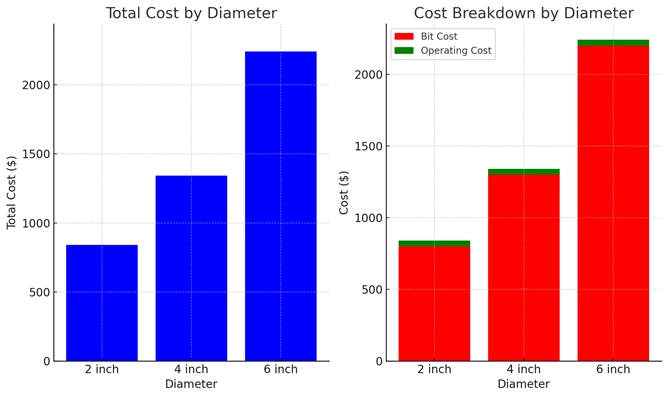
As you can see there is an optimum horsepower for each combination of diamond core bit diameter and material. Optimum horsepower can be determined where sum of the Diamond core Bit cost and Operating Cost are at a minimum. Conditions used in this experiment resulted in the following optimum drilling horsepower
Non Reinforced Concrete Reinforced Concrete
2” diameter 3.5 HP 1.5 HP
4” diameter 5.0 HP 3.0 HP
6” diameter 8.0 HP 3.5 HP
horsepower levels above were determined assuming standard Operating cost of $25.00 per hour.
As this experiment shows the optimum horsepower level for reinforced concrete is lower than for non reinforced concrete
Knowing as much as possible about the material to be drilled and relaying this information to diamond core bit manufacturer is important to obtain the right diamond core bit for your application. Before we can recommend the right diamond core bit for your application, knowing what type of aggregate that is to be drilled as well as whether reinforcing steel will be present and maximum drilling depth. Some concrete and allied materials are harder than others. Hence more difficult and longer to drill. For example: Limestone, slag and coral aggregate are relatively soft and abrasive materials. These are easily drilled with very fast drilled speed. On other hand concrete with river gravel or quartzite is of medium difficult to drill. Flint or granite aggregate is generally considered among the most difficult to drill.
The size of aggregate can also play a factor in overall drilling performance of diamond core bit. Concrete aggregate are frequently in range of ½” to 2”. Concrete made with 2” flint aggregate will be extremely difficult to drill, but concrete with ½” fling aggregate is drilled much more easily.
In addition to the aggregate the type of sand used to make the concrete can influence the selection of diamond core bit. Many natural sands are quartzitic and have been rolled by water for many years and are smooth and dull. Similarly, manufactured sand usually has sharp and abrasive edges that can wear a diamond core bit bond very quickly.
Drilling concrete made with hard aggregates also requires more power. If there is not enough power, diamond core bit speed should be reduced. Diamond Bits used to drill hard aggregates should have segments with tough diamonds and a soft metal bond matrix. Otherwise the diamond particles will wear even with the bond surface and the diamond bit glazes over and is unable to drill. At same time segments for drilling soft aggregates should have hard diamond bond, so that diamond particles are not lost before their drilling life is consumed. Green concrete is usually very abrasive and requires hard diamond bond.
DRILLING REINFORCED CONCRETE
Drilling reinforced concrete is more difficult, takes longer, and costs more than almost any other concrete and allied material. Diamond core bit life and drilling speed is considerably reduced when drilling this material. On many applications diamond core bit life can be reduced by as much as 50% depending on steel amount and depth in concrete.
When a diamond core bit reaches and hits steel, you will often notice sparks coming from the drilling zone. This is an indicator that you have hit reinforced steel. The operator should reduce drilling speed and decrease coolant flow.
Drilling Speed (RPM)
Optimum operating speeds for drilling concrete are around 10,000 surface feet per minute. It is important for the operator to maintain appropriate operating conditions to maximize diamond core bit life, drilling speed and overall performance. Actual drilling speed will usually have to be adjusted to accommodate the aggregate type and amount of steel encountered in concrete being drilled. Usually higher drilling speeds make the diamond core bit act harder and often lengthen diamond core bit life. The trade off is slower drilling speed. Decreasing diamond core bit speed will make the diamond bit act softer, but diamond core bit life will also decrease.
If you are not sure about the correct or optimal drilling sped to use for particular material/application, it is better to error on side of lower drilling speed rather than higher speed. Start in the lower RPM range, and once the diamond core bit is working well, increase the speed to optimize drilling life. When drilling softer abrasive materials, a faster drilling speed and forward traverse rate and more coolant should be used.
Machine Drive Power
Amount of power available to diamond core bit being used is also another important variable to consider in optimizing your concrete diamond drilling application. Drilling Machine will less power than required can result in diamond core bits that will glaze over, resulting in slow drilling speeds.
Drilling machine power requirements for typical concrete drilling operations is 2 to 20 horsepower. In order for diamond core bit manufacturer to provide best diamond bit for your application, it is important to know the maximum horsepower of the drilling machine used. Frequently diamond core bits with soft bond segments will wear faster if used with high horsepower drilling machines. However this is not always the case, and there are numerous exceptions to this rule.
Diamond core bits made with segments of hard bond will work better on higher horsepower drilling equipment. Diamond core bits require that right amount of pressure be applied for optimal drilling results. In order to maintain constantly sharp diamond crystals, sufficient amount of pressure should be applied for the material being drilled. If too little pressure is applied, diamond crystals will become dull and diamond bit stop drilling or drill very slowly. At same time operator must be careful to not over do it, because too much pressure can damage the diamond core bit.
CONCRETE & ALLIED DRILLING MATERIALS
CONCRETE AGE
Understanding how concrete cures is crucial for effectively drilling into it, as the curing time and conditions significantly influence the interaction between diamond core bits and the concrete. The curing process is when concrete develops its strength and durability through hydration, where water reacts with Portland cement, leading to a gradual hardening. This process can last from a few days to several weeks and directly affects the concrete's hardness and abrasiveness.
Several factors influence concrete's curing process. Weather conditions such as temperature and moisture are pivotal, with optimal curing occurring at moderate temperatures and high humidity to slow the evaporation of moisture. In hot weather, curing accelerates, but the rapid moisture loss can weaken the concrete. Conversely, cold weather can significantly slow down or even stop the curing process if temperatures drop below freezing. The time of year also plays a role, as winter conditions might require heated enclosures or additives to prevent freezing, while summer may necessitate measures to prevent rapid moisture loss and cracking. The composition of the concrete, including admixtures like accelerators and retarders, the type and size of aggregate, and the proportion of sand, also affects how quickly the concrete gains strength.
When drilling into concrete, understanding its age is crucial. Newly poured concrete, being softer and less abrasive, allows for faster drilling speeds and easier cutting. However, as concrete ages and cures, it becomes harder and more abrasive, increasing wear on diamond core bits and necessitating the use of bits designed for hard, abrasive materials to maintain efficiency and extend the lifespan of the bit. The age and hardness of the concrete should guide the selection of diamond core bits, and the drilling strategy should adapt accordingly. Younger concrete may require lower pressure to avoid over-penetration and potential structural damage, while older concrete might need higher pressures and slower speeds to effectively penetrate the harder material.
Pre-drilling assessments such as rebound hammer tests or ultrasonic pulse velocity can help determine the concrete's maturity and optimize the drilling approach. Continuous monitoring of drilling performance and regular inspection of bits for wear are also important to adjust techniques in real-time, improving outcomes and reducing the risk of equipment failure.
GREEN CONCRETE
Green concrete refers to freshly poured concrete that hasn't fully hardened, typically within the first 6 to 48 hours after pouring. During this phase, the sand in the concrete mix hasn't completely bonded with the cement mortar, making the aggregate particles less stable. This characteristic affects both the cutting process and the tools used.
When cutting green concrete, the loosely bonded sand particles detach more readily, becoming part of the slurry that flows freely during the cutting process. This slurry, filled with abrasive particles, significantly increases the wear on cutting tools, particularly diamond core bits. To handle the abrasiveness, it’s essential to use diamond core bits specifically designed for green concrete, which feature harder bond matrices that resist wear better than standard bits. These bits are equipped to release diamonds more readily to maintain cutting efficiency despite accelerated wear.
The technique for cutting green concrete requires careful adjustments, such as lower feed rates and ample water flow, to manage the abrasive slurry effectively and keep the cutting surface cool. Cutting at this stage offers the advantage of easier penetration due to the concrete's softer state, but this comes with the risk of increased tool wear and potential damage if not timed correctly. The optimal cutting time can vary based on environmental factors and the concrete’s specific properties, requiring operators to frequently check tool wear and adjust or replace tools more often than when cutting fully cured concrete.
CURED CONCRETE
Cured concrete has typically set at least 48 hours. The sand has completely bonded with the mortar and the concrete has reached full hardness.
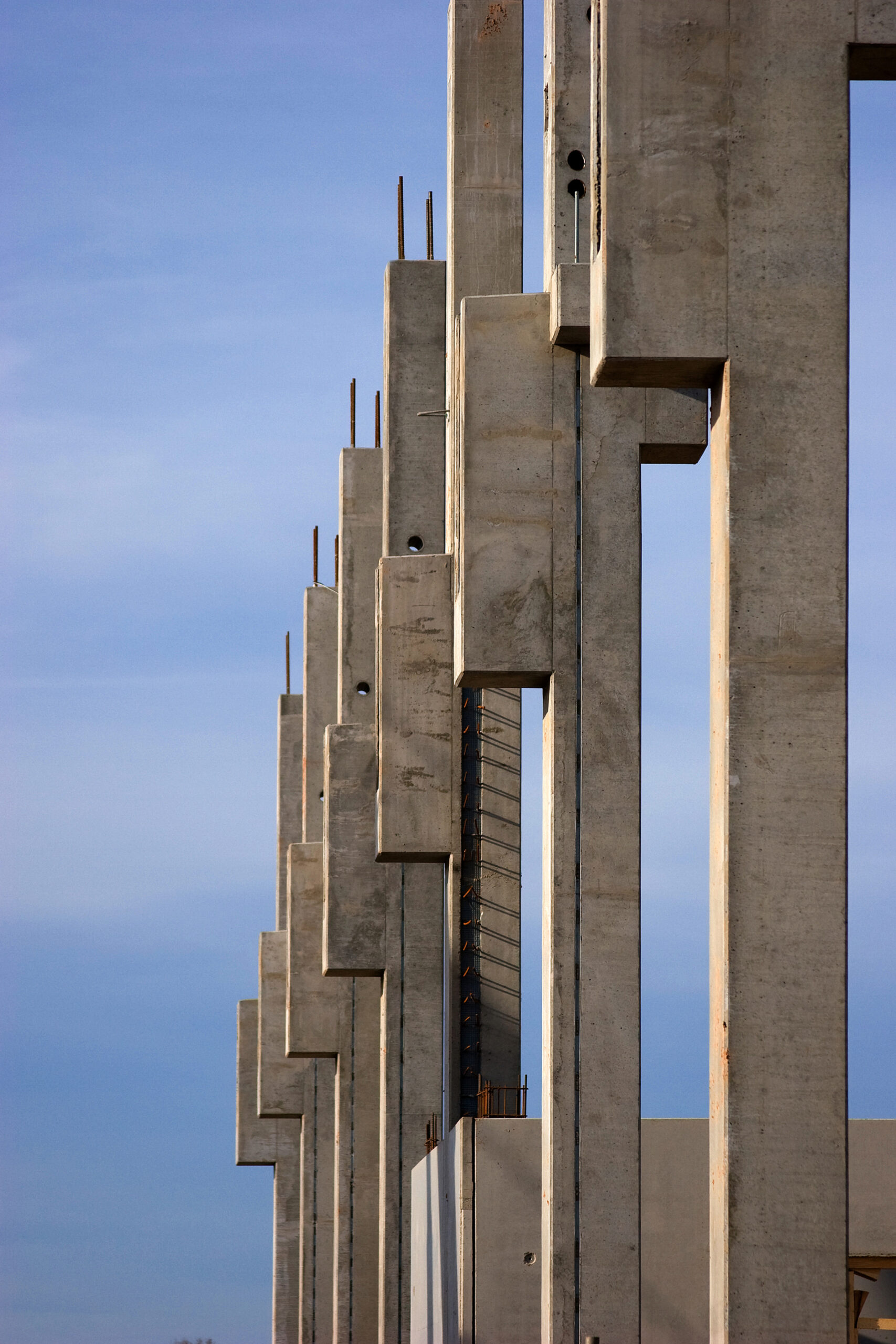
AGGREGATE
Both the size and type of aggregate have a great impact on the overall hardness of concrete. The aggregate can make up as much as 75% of the total volume. As a general rule, larger aggregate tends to make the concrete act harder, slowing drilling process. Smaller aggregate makes the concrete act softer, allowing for faster drilling.
Aggregate Size Impact
Larger pieces of aggregate, typically measuring up to 1.5 inches in diameter, increase the hardness of the concrete. This occurs because the larger stones provide a robust matrix that is more challenging to penetrate, leading to slower drilling speeds. Such aggregates often require more robust drilling equipment with higher torque and power to effectively break through the concrete.
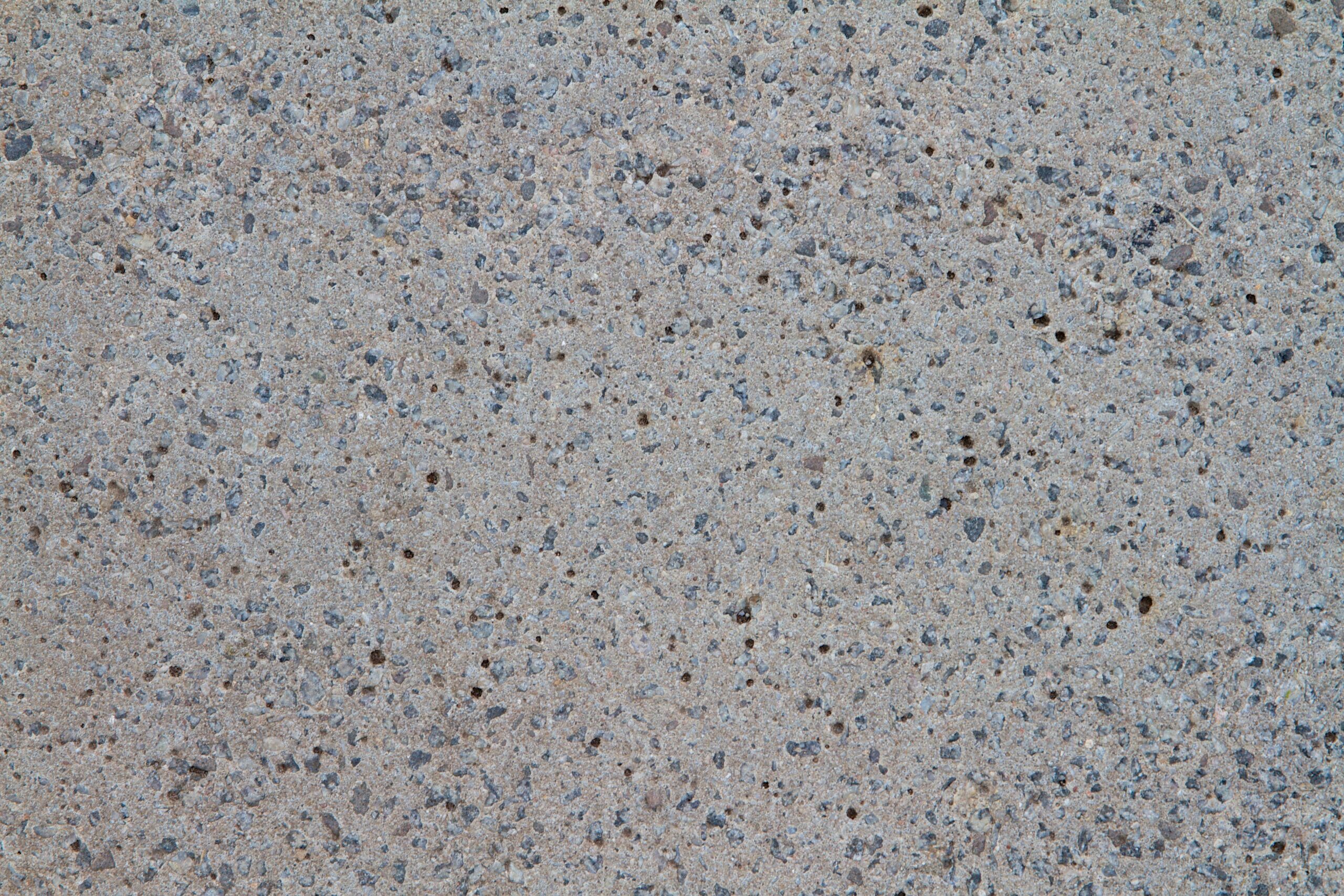
Conversely, smaller aggregate sizes, about 3/8 inches in diameter, make the concrete act softer, facilitating faster drilling. The smaller size of the aggregate means there are more points of contact between the aggregate and the cement paste, which might create a less cohesive matrix, allowing for easier penetration by drilling tools.
Aggregate Type Impact
The mineral composition of the aggregate significantly affects the concrete's hardness. Aggregates are chosen based on availability, cost, and the specific needs of the construction project, including the desired durability and finish of the concrete. Granite, known for its hardness and durability, has a Mohs hardness rating of around 6-7 and is commonly used in high-traffic areas or structures requiring high strength. Limestone, typically softer than granite, has a Mohs hardness of about 3-4, is easier to drill but provides less wear resistance. Sandstone, with a Mohs hardness of 6-7, similar to granite, is also durable but varies significantly in density and strength based on its composition and the depth at which it was quarried. Gravel, often used as a coarse aggregate, has a hardness that depends on the types of rocks included, generally ranging from 6-7 on the Mohs scale.
The type of diamond core bit used must correspond to the hardness of the aggregate. For harder aggregates like granite, soft bond type diamond core bits preferable for their ability to handle tough materials. Adjustments in drilling speed and the power of the drilling equipment may be necessary depending on the aggregate size and type. Harder aggregates require slower speeds to prevent overheating and wear on the drill bits. The use of coolants can help in reducing the temperature and removing debris during the drilling process, which is particularly important in harder concrete to prolong the life of the drill bits.
Differences between large and small aggregates
|
Aspect |
Large Aggregate |
Small Aggregate |
|---|---|---|
|
Size |
Up to 1.5 inches in diameter |
About 3/8 inches in diameter |
|
Concrete Hardness |
Increases concrete hardness; acts as a robust matrix, slowing drilling |
Makes concrete act softer, allowing for faster drilling |
|
Drilling Speed |
Slower due to increased hardness and resistance |
Faster due to less cohesive matrix |
|
Drill Bit Type |
Requires more robust drilling equipment (e.g., high-torque drill bits) |
Can use standard drilling equipment |
|
Typical Use |
Ideal for high-strength applications and areas with high traffic |
Suitable for projects requiring less wear resistance |
Detail the types of minerals commonly used for aggregate and their relative hardness:
|
Mineral Type |
Common Use |
Mohs Hardness |
|---|---|---|
|
Granite |
High traffic areas, structures requiring high strength |
6-7 |
|
Limestone |
General construction where less wear resistance is adequate |
3-4 |
|
Sandstone |
Diverse applications depending on specific stone qualities |
6-7 |
|
Gravel |
Coarse aggregate, varied applications depending on rock type |
Dependent on rock type, typically 6-7 |
STEEL REINFORCING CONCRETE
The inclusion of steel reinforcement, commonly known as rebar, significantly affects the properties of concrete, particularly its hardness and the complexity involved in drilling or cutting through it. Rebar, typically made from steel, is embedded into concrete to compensate for its relatively low tensile strength and ductility, enhancing the material's ability to handle tension and flexural stresses. This makes it indispensable in a wide range of construction applications.
The presence of rebar increases the overall hardness of concrete. Steel, having a much higher hardness compared to the cement paste and aggregate components of concrete, introduces substantial resistance when encountered by drilling equipment. As the amount of rebar increases, so does the effective hardness, complicating the drilling process by necessitating more force to penetrate and increasing wear on the equipment. This often requires frequent bit changes or the use of specialized drill bits, such as those tipped with diamond or carbide, which are designed to handle both concrete and steel effectively.
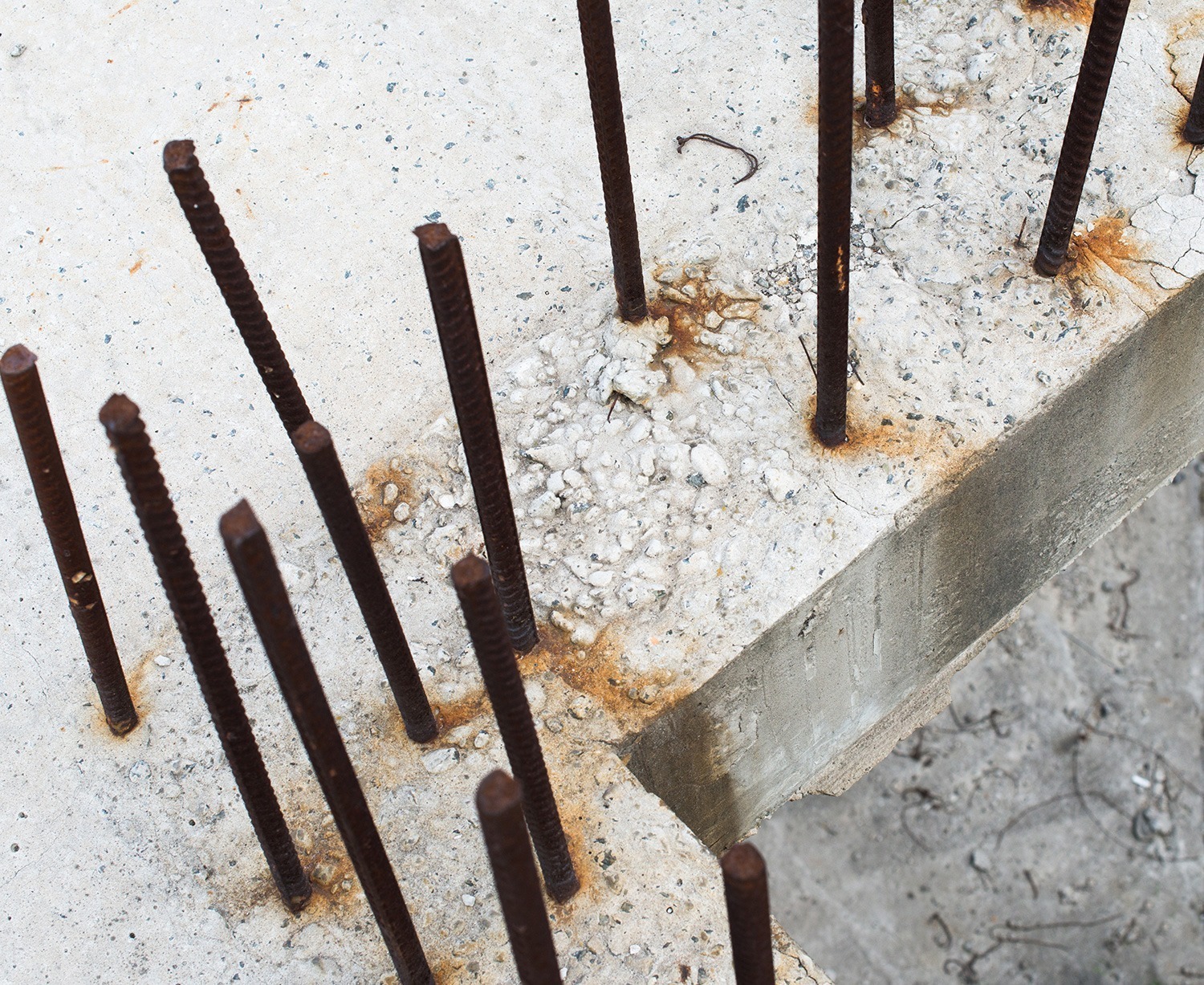
When drilling through reinforced concrete, adopting slower speeds may be necessary to manage the heat buildup and reduce the risk of damaging the drill bits or the rebar itself. Applying adequate coolant or water can help reduce the temperature during drilling, which is crucial when cutting through steel reinforcement to prevent overheating and potential weakening of the steel.
The configuration and amount of rebar directly affect the load-bearing capacity of the concrete structure. Proper understanding and mapping of rebar placement are crucial during construction planning to ensure structural integrity. The arrangement of rebar within concrete also influences how the material behaves under different types of loads, including tension, compression, and shear. Incorrect placement or insufficient amounts of rebar can lead to premature structural failures.
Advanced imaging techniques such as ground-penetrating radar (GPR) can be used to identify rebar placement before drilling, aiding in planning the drilling operation to avoid excessive wear on tools and potential damage to the structure. The presence of more rebar often implies increased costs and time requirements for drilling due to the challenges posed by the material's hardness and the need for specialized equipment.
ASPHALT
Drilling into asphalt requires specific considerations due to its unique properties such as its softness and abrasive nature, which significantly affect the performance and requirements of diamond core bits.
Characteristics of Asphalt
Asphalt is notably softer than concrete and does not cure to the same hardness levels. Its consistency includes small-sized aggregate which, unlike concrete, minimally impacts the cutting process due to the softness of the asphalt's binder (bitumen). This allows easier penetration but causes greater abrasion to the cutting tools.
Impact on Diamond Core Bits
The abrasive nature of asphalt demands diamond core bits that can handle large volumes of abrasive dust and debris without excessive wear.
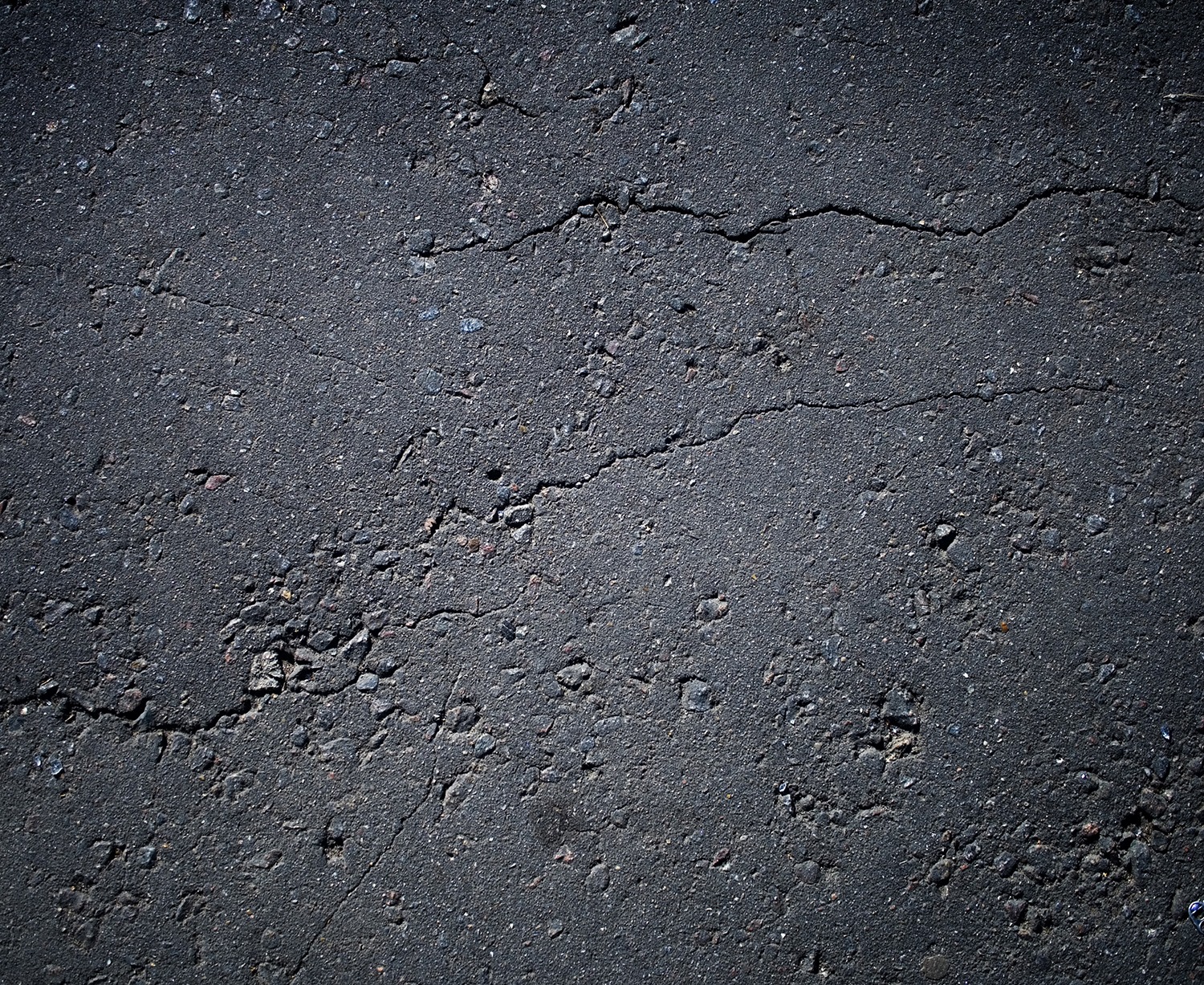
These bits need undercut protection to guard against the rapid wear of the metal matrix that holds the diamonds. This protection, usually in the form of additional layers or segments, prevents the exposure of the bit's shank, a condition known as undercutting. It ensures that the bit maintains its integrity and functional geometry, even under intense abrasive conditions.
Optimizing the diamond grit size and concentration on the bit for asphalt is crucial to balance between penetration efficiency and lifespan. Smaller diamond grits can wear out faster due to the high abrasiveness of asphalt, whereas a higher diamond concentration might slow the cutting speed but increase endurance.
Cooling and Operational Considerations
Unlike concrete, asphalt's lower hardness allows for faster cutting speeds, which can increase heat buildup. Adequate cooling, typically through water, is essential to prevent overheating of the diamond bit. This not only extends the life of the bit but also helps in removing asphalt debris from the cut, maintaining efficiency and preventing potential clogging or binding of the bit.
Operators must select diamond core bits specifically designed for asphalt, featuring hard bonds to resist abrasive conditions. These bits are tailored to eject asphalt debris effectively and resist the thermal and mechanical stresses encountered during cutting. Higher operational speeds can be employed due to the soft nature of asphalt, but it's important to match the speed with appropriate cooling measures to avoid premature wear or damage.
Regular inspection of the diamond core bit is recommended to check for signs of wear, undercutting, or damage. Prompt replacement of worn bits is crucial to maintain cutting efficiency and safety.
BRICK & BLOCK
Drilling or cutting through brick and block requires a nuanced approach due to their distinct material properties. Concrete blocks are known for their soft, abrasive qualities, made from cement and aggregate that create a highly abrasive material to cutting tools. In contrast, bricks tend to be harder and less abrasive. Manufactured from various clays and kiln-fired at high temperatures, bricks can range from relatively soft and porous to extremely hard and dense depending on the clay mixture, method of manufacture, and firing temperature.
There is a large variety of brick types available, each designed to provide specific qualities. For instance, common burnt clay bricks are used for general work and do not require aesthetic appeal, while sand lime bricks offer a smoother finish suitable for visible surfaces. Engineering bricks are chosen for their high strength and low water absorption, necessary for civil engineering projects. Firebricks are designed to withstand high temperatures and are typically used in furnaces and fireplaces.
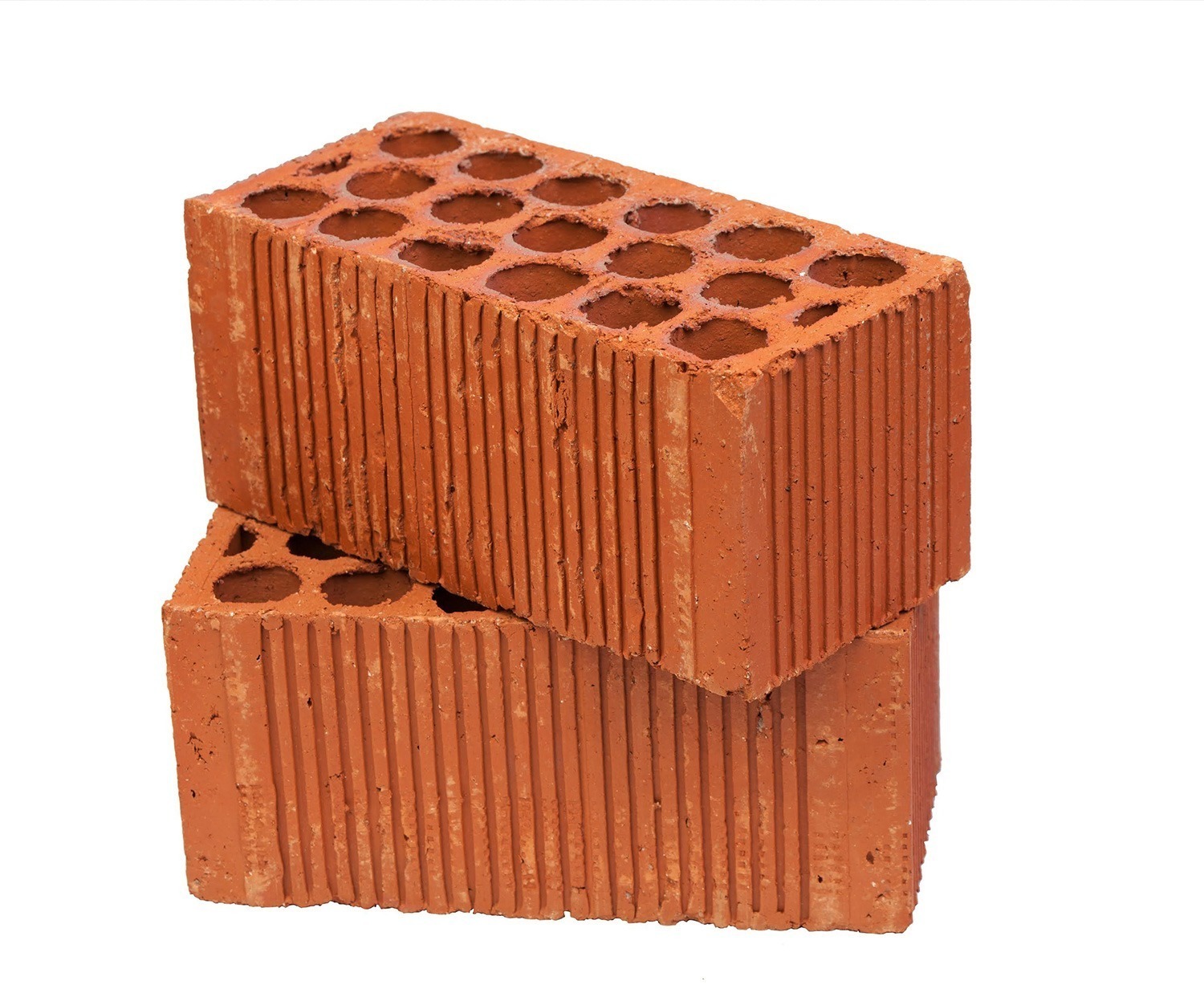
When selecting tools for cutting brick and block, the type of diamond core bit must be suitable for the material's hardness and abrasiveness. Concrete blocks require bits designed for abrasive materials to handle the wear from the aggregate. For harder bricks, bits that deliver a clean cut without excessive wear are necessary. Both brick and block cutting benefit from adequate cooling, typically with water, to extend the life of the cutting tools and prevent overheating. The operational speed should be adjusted based on the material's hardness; softer materials can be cut faster, while harder materials need a slower speed to minimize tool wear.

Brian is an experienced professional in the field of precision cutting tools, with over 27 years of experience in technical support. Over the years, he has helped engineers, manufacturers, researchers, and contractors find the right solutions for working with advanced and hard-to-cut materials. He’s passionate about bridging technical knowledge with real-world applications to improve efficiency and accuracy.
As an author, Brian Farberov writes extensively on diamond tool design, application engineering, return on investment strategies, and process optimization, combining technical depth with a strong understanding of customer needs and market dynamics.

ARE YOU USING DIAMOND CORE BITS
FOR YOUR APPLICATION?
LET US
HELP YOU
HAVING ISSUES WITH
YOUR CURRENT DIAMOND CORE BITS?
Knowledge Center
Diamond Tool Coolants Why, How, When & Where to Use
Selecting the Right Coolant Method for your Diamond & CBN Tools
How to Selecting Right Diamond Tools for your application
How to properly use Diamond Tools
Why use diamond
Diamond vs CBN (cubic boron nitride) Tools
What is Diamond Mesh Size and how to select best one for your application
What is Diamond Concentration and which to use for your application
Choosing The Correct Diamond Bond Type
Diamond Core Bit Ultimate Guide
Concrete Drilling Metrics – Optimizing your Diamond Core Bit
Optimal Drilling Performance – How to Properly Use Diamond Core Bits
Select Right Diamond Drill for your Application
How to Properly Use Precision Diamond Drills
Diamond Drills Guide
Diamond Tools Guide – Selecting Right Drills & Tools for your application
Optimizing your Diamond Drilling Operation
Diamond Core Drill & Drill Trouble Shooting Guide
Understanding & Calculating Return on Investment for Diamond Core Drills & Other Tools
Understanding Tradeoffs – Searching for Perfect Diamond Drill & Tool

Brian is an experienced professional in the field of precision cutting tools, with over 27 years of experience in technical support. Over the years, he has helped engineers, manufacturers, researchers, and contractors find the right solutions for working with advanced and hard-to-cut materials. He’s passionate about bridging technical knowledge with real-world applications to improve efficiency and accuracy.
As an author, Brian Farberov writes extensively on diamond tool design, application engineering, return on investment strategies, and process optimization, combining technical depth with a strong understanding of customer needs and market dynamics.


